Blog and Articles
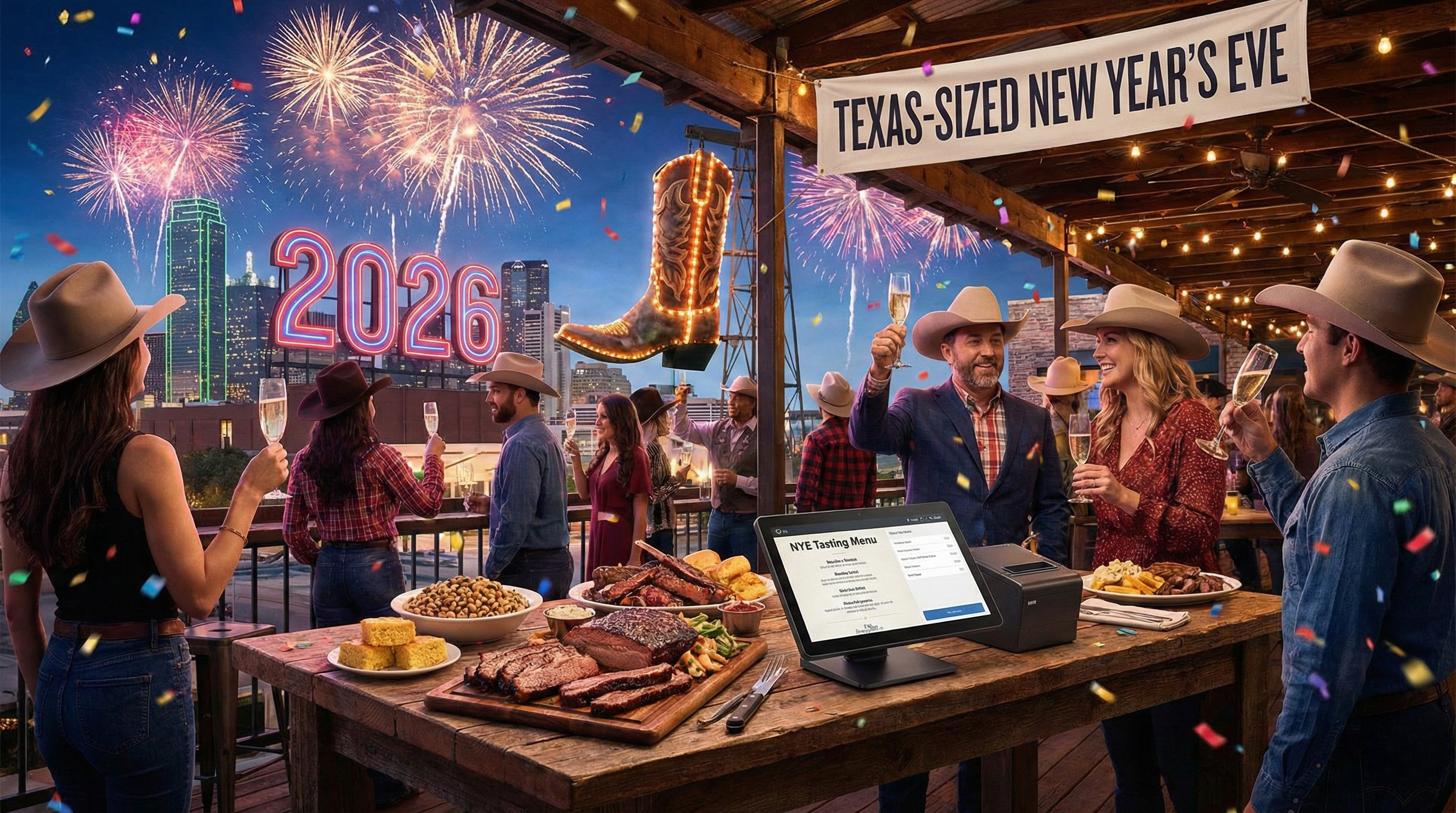
Christmas Cocktails That Sell: 12 Festive Drinks to Boost Your Holiday Revenue

.png)
Holiday Staff Management for QSRs and Liquor Stores: How to Protect Morale and Still Win December

.png)


5 min read
There is a saying we all know: Everything is bigger in Texas. And if there is one night of the year that demands big energy, big flavors, and big hospitality, it’s New Year’s Eve.
For restaurant owners, December 31st isn't just a party; it’s the Super Bowl of the hospitality calendar. It’s your final sprint to boost Q4 revenue and your first opportunity to set the tone for the new year. But let’s be honest — the standard "champagne and prix fixe" formula is getting a little stale. In a state as diverse and culturally rich as Texas, your guests are craving unique new year's eve ideas that feel like home but taste like a celebration.
Whether you run a high-end steakhouse in Dallas, a funky taco spot in Austin, or a family-style BBQ joint in Houston, the competition will be fierce. To stand out, you need new year's party ideas that go beyond the balloon drop. You need ideas that are operationally sound and profitable.
Here are 10 creative, Texas-sized New Year’s Eve ideas to pack your tables and ring in 2026 — and exactly how to execute them efficiently using your restaurant technology.
See Also: Master the art of cross-selling and upselling with your POS
1. The "Lucky" Texas Tasting Menu
In the South, and especially in Texas, we don't just eat for flavor on New Year's; we eat for fortune. Superstition runs deep in our culinary roots. You can capitalize on this by curating a "Good Luck" tasting menu that tells a story.
Forget the generic surf-and-turf. Build a narrative around the Texas "Holy Trinity" of New Year’s luck:
- Black-Eyed Peas: Representing prosperity (Think: A refined Hoppin’ John risotto or a black-eyed pea hummus with house-made lavash).
- Collard Greens: Representing "folding money" (Think: Braised greens with ham hocks or a crispy kale garnish).
- Cornbread: Representing gold.
- Pork: Representing forward progress (because pigs root forward, not backward!).
Making it Work on the Line: While tasting menus are great for guests, they can be a nightmare for servers if they have to ring in five separate items for every seat. To keep the kitchen flowing, set this up in your point of sale as a single "Lucky Menu Bundle."
You can configure "forced modifiers" for each course choice (e.g., the system forces the server to choose Soup OR Salad before they can move to the next screen). This ensures the kitchen gets a clean, complete ticket every time, reducing errors and speeding up service. Additionally, before you finalize the dishes, pull your "Item Sales Report" from last NYE. Did the pork chop sell better than the steak? Use your historical data to build a menu you know will sell, rather than guessing.
2. "Noon Year's Eve" Family Rodeo
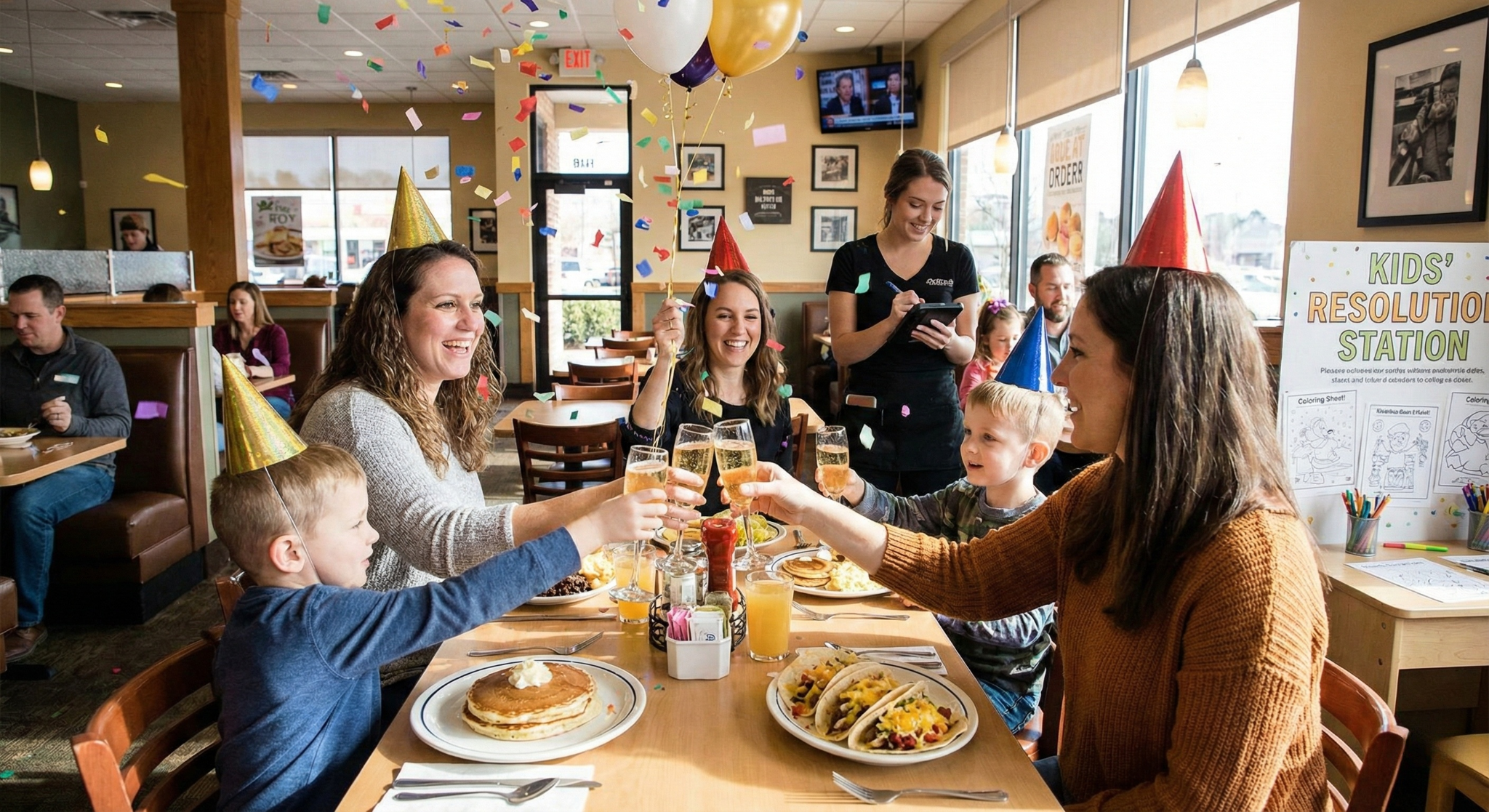
New Year’s Eve falls on a Wednesday this year. This means many parents will be looking for new year's party ideas that allow them to celebrate without keeping the kids up until midnight. Enter the "Noon Year’s Eve" bash.
Shift your focus to the daytime crowd—specifically families. Host an event from 11:00 AM to 1:00 PM with a "countdown" to 12:00 noon.
- The Hook: Sparkling apple cider toasts, a balloon drop at noon, and a "kids' resolution" coloring station.
- The Menu: Keep it simple and high-margin. Breakfast tacos, pancakes, and sliders.
Managing the Labor Crunch: Lunch shifts are usually lighter on staff, but this event effectively compresses a dinner rush into two hours. To avoid being understaffed, use your labor reports to analyze sales-per-labor-hour from your busiest Sunday brunch. This data helps you schedule the exact number of servers needed for a high-intensity, short-duration rush.
Furthermore, since this is a time-sensitive event (everyone tries to leave 15 minutes after the "noon" drop), speed is vital. Equip your servers with handheld tablets to take orders and payments tableside. This prevents the "bottleneck at the register" when 50 families try to pay at 12:15 PM, allowing you to turn those tables over for the regular lunch crowd immediately after.
3. The "Red Dirt & Bubbles" Gala
If you are in Texas, you know that Country and Red Dirt music are the heartbeat of the state. While other venues are hiring Top 40 DJs or jazz quartets, lean into your roots for one of the most authentic new year's eve ideas around.
Host a "Red Dirt & Bubbles" night. The concept is a high-low mix: elegant champagne service paired with gritty, authentic live country music.
- The Vibe: "Denim and Diamonds."
- The Drink: Partner with a Texas winery (like Messina Hof or Becker Vineyards) or serve "Ranch Water Royale" (Topo Chico, premium tequila, lime, and a splash of champagne).
Streamlining Service in a Crowd: In a live music environment, guests don't stay seated. They mingle, dance, and move to the bar. Don't force them to fight their way back to the main bar queue for a refill — that’s lost revenue.
Modern POS systems allow you to swipe a card once to open a tab, and then access that tab from any terminal in the venue. You can even send servers into the crowd with handheld devices to take drink orders on the fly. This seamless "tab roaming" encourages guests to order more because it’s convenient. If they can order a second Ranch Water without leaving the dance floor, you’ve just increased your beverage sales effortlessly.
4. The Tamalada To-Go Experience
For many Texans, specifically those with Hispanic heritage, NYE means tamales. Hosting a "Tamalada" (tamale-making party) is a beloved tradition, but it’s labor-intensive.
Solve that problem for your customers. Create "Tamalada Survival Kits" for pickup. This is one of those new year's party ideas that captures revenue from the "stay-at-home" market without clogging up your dining room.
- The Kit: Dozens of hot tamales (pork, chicken, bean, and cheese), sides of charro beans, salsa, and a gallon of pre-mixed margaritas.
- The Upsell: Add reheating instructions and a QR code that links to a curated Spotify playlist of Tejano hits.
Controlling the Kitchen Chaos: The risk here is the kitchen getting slammed with 500 tamale orders at 6:00 PM while trying to serve dinner guests. You can mitigate this by configuring your online ordering system to accept "Future Orders" starting December 1st.
This allows you to collect revenue weeks in advance. More importantly, it gives your kitchen a precise prep list (e.g., "We need exactly 400 pork tamales by 5 PM"). You can also set "throttling" rules in the system to limit the number of To-Go orders accepted per 15-minute slot, ensuring the kitchen pace remains manageable.
5. The "Morning After" Rescue Kit
Let’s be real—New Year’s Day in Texas is often spent recovering from New Year’s Eve. Anticipate your customers' needs by selling them the cure before they even get the hangover.
As guests pay their bill on NYE, offer a pre-packed "Hangover Cure" bag to take home for the next morning.
- Contents: A giant breakfast burrito (cold, ready to heat), a bottle of high-quality Bloody Mary mix (just add vodka), a Topo Chico, and maybe some B-12 vitamins.
- Marketing: "You’ll thank yourself tomorrow."
Automating the Upsell: Your servers will be incredibly busy closing out tabs; they might forget to mention the upsell. You can use your technology to remind them. Program your POS to display a pop-up prompt on the screen when the server hits the "Print Check" button: "Upsell Hangover Kit?"
Ensure the kit is set up as a "Fast Button" on the main screen so it can be added in less than a second. This small tech tweak standardizes the sales process and can significantly increase your check average by $15-$20 per table without extending the dining time.
6. Patio Polar Bear Party (with Heaters!)
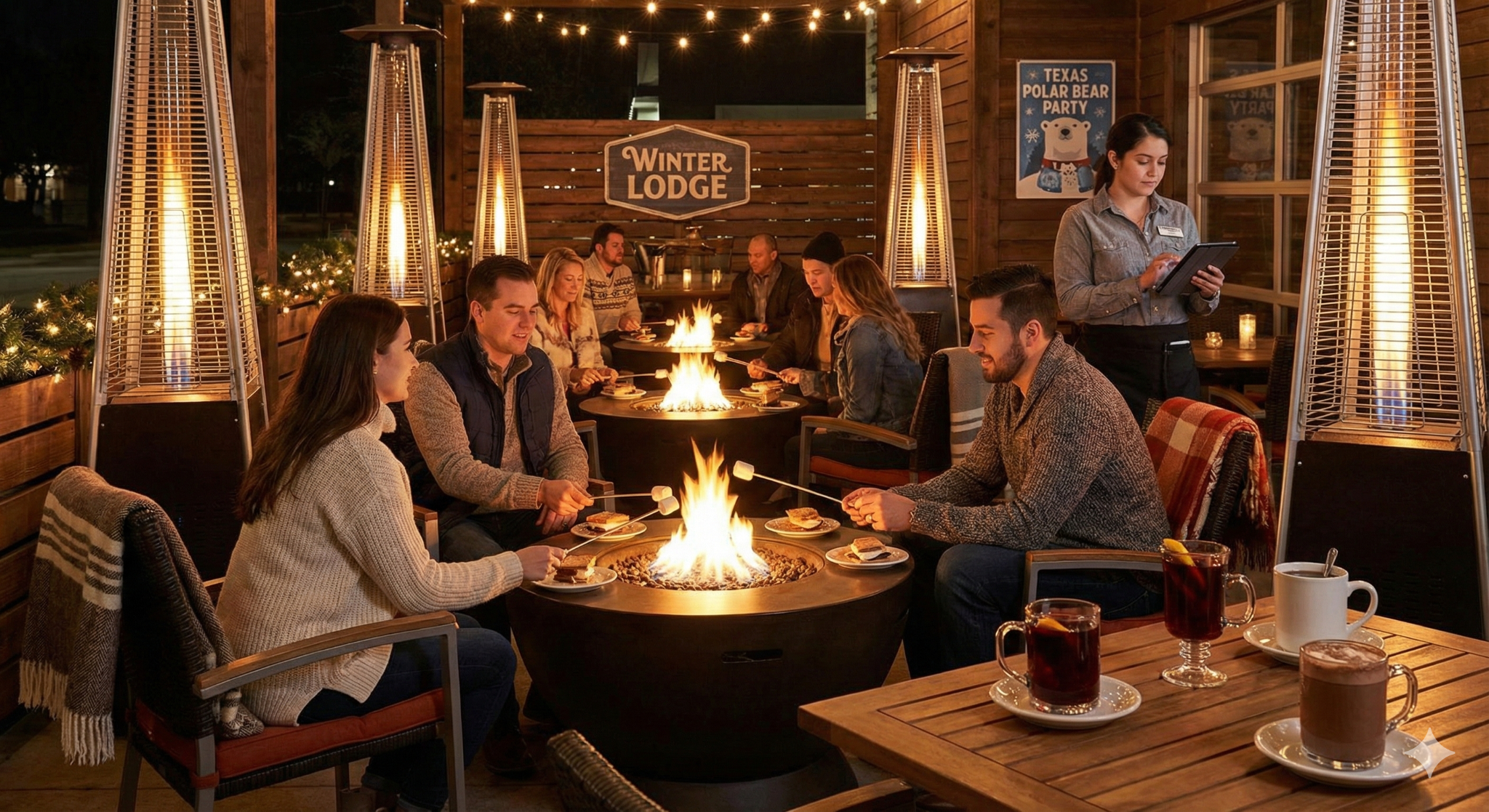
Texas weather in late December is a gamble. It could be 70 degrees, or it could be freezing. But Texans love a patio.
If you have outdoor space, don't abandon it. Market it as an "Ice Bar" or "Winter Lodge" experience. This effectively expands your capacity for new year's eve ideas.
- The Setup: Rent extra patio heaters and fire pits. Offer blankets.
- The Menu: Hot cocktails are a must. Mexican Hot Chocolate with tequila, Mulled Wine, or Hot Toddies.
- The Draw: S’mores kits for the table. Giving guests something to do (roasting marshmallows) keeps them engaged.
Tracking High-Cost Inventory: Specialty items like S'mores kits or the premium chocolate used in cocktails can disappear quickly or result in waste if not tracked. Set these up as inventory items in your system (e.g., 1 Kit = 4 graham crackers + 1 chocolate bar + 2 marshmallows).
Set a "Low Stock Alert" on the manager’s tablet. If you get down to your last 5 kits, the manager gets a notification and can either 86 the item or rush to the back for more supplies. This real-time visibility prevents the embarrassment of selling a "Winter Experience" item that you ran out of an hour ago.
7. The Midnight "Boot Drop"
We’ve all seen the ball drop in Times Square. It’s classic, but it’s not us. Create a localized moment that your guests will want to film and share.
Commission a local artist or use a prop to drop a giant "Cowboy Boot" or a massive "Lone Star" at midnight.
- The Stunt: Project the countdown on a big screen.
- The Toast: Instead of just champagne, offer a complimentary "Shot of Shiner" or a mini-margarita toast at midnight.
Handling the Midnight Rush: Giving away a free toast (or selling a discounted one) at midnight can be a logistical headache. Do you ring them up? Do you spill them? To keep inventory straight, create a specific "Midnight Toast" button in the POS that costs $0.00 but deducts the inventory count.
If you are selling the toast, use "Happy Hour" automation. Set the price of the "Boot Drop Shot" to automatically change to $5.00 from 11:45 PM to 12:15 AM. By automating the price change, your bartenders don't have to remember the special pricing or manually adjust tickets while they are three-deep in customers.
8. Upscale BBQ Prix Fixe
Texas BBQ is usually associated with butcher paper and plastic trays. Flip the script for New Year’s Eve.
Offer a white-tablecloth BBQ experience. This appeals to the "meat and potatoes" crowd who are looking for fancy new year's party ideas but still want food they recognize.
- The Food: Wagyu brisket, lobster tail with garlic butter, truffle mac and cheese, and smoked prime rib.
- The Atmosphere: Candlelight, real silverware, and table service.
Elevating Service with Tech: Upscale BBQ requires upscale guidance, and your servers might need help shifting from "casual BBQ" mode to "fine dining" mode. You can program your ordering screens to help them.
When a server selects "Wagyu Brisket," configure a modifier screen that suggests specific wine or bourbon pairings (e.g., Prompt: Suggest Texas Cabernet or Smoked Old Fashioned). This acts as a digital sommelier, helping younger or less experienced staff make premium recommendations. It boosts confidence for the staff and boosts beverage revenue for the house.
9. The Resolution Wall
Community is everything in the hospitality industry. Turn a wall of your restaurant (or a large chalkboard) into a "2026 Resolution Wall."
Provide silver and gold sharpies and encourage guests to write their hopes for the new year on the wall.
- The Incentive: Pick one "resolution" at random at the end of the night and award that guest a gift card for 2026.
- The Content: Snap photos of the best resolutions for your social media.
Turning Fun into Leads: This isn't just a fun game; it's a lead-generation tool if you play your cards right. Instead of just writing on the wall, have guests scan a QR code on their receipt to "register" their resolution for the prize draw.
This digital form can sync directly with your Customer Relationship Management (CRM) system. Now, you have their email and birthday captured. You can send them a personalized "Come back and check on your resolution!" email in February when sales are typically slower, turning a one-night guest into a repeat customer.
10. Ticketed "All-Inclusive" Night
One of the biggest risks for restaurants on NYE is "campers"—guests who buy one appetizer and sit at a table for four hours waiting for midnight. This kills your table turnover and your profits.
Switch to a ticketed model for the night.
- The Deal: Sell tickets for $100–$200 per head (depending on your market).
- The Value: Includes a 4-course meal, open bar (or drink tickets), live music, and the midnight toast.
Securing the Revenue: Handling large sums of money upfront requires a secure system. Use your POS to process these tickets as "Deposits." When the guest arrives, the server opens the ticket and applies the pre-paid deposit instantly.
You can also use your floor plan management features to assign specific ticket holders to specific tables in advance. This allows you to visualize the entire night’s seating chart before the doors even open, ensuring you haven't overbooked your capacity and that VIPs get the best seats in the house.
Executing the Vision
Great new year's eve ideas are nothing without execution. The difference between a profitable night and a chaotic one often comes down to the systems you use to support your staff.
If you are trying to run a "Lucky Tasting Menu" or a "Noon Year's Eve" rush with handwritten tickets or a legacy register, you are setting yourself up for stress. Modern systems like OneHubPOS act as your silent partner, handling the math, the inventory, and the communication so you can focus on the hospitality.
Your guests are coming for the Texas charm, the food, and the party. Don't let slow service, "86'd" items, or confused servers ruin the vibe.
Ready to upgrade your operations before the countdown begins?
OneHubPOS offers an all-in-one restaurant management solution designed to help you handle the heat of the kitchen. From tableside ordering to real-time inventory tracking and customer loyalty tools, we help you focus on the food, not the friction. Click here to schedule your Free Demo of OneHubPOS today!
.png)

5 min read
December is the only month of the year where a garnish of rosemary and a cinnamon stick can justify a $4 price increase.
For bar and liquor store owners, the holiday season isn't just about "holiday cheer" — it’s about capitalizing on the festive tax. Customers want to spend more in December. They are actively looking for reasons to upgrade from their usual beer or house wine to something special, photogenic, and higher margin.
But here is the trap: If your holiday menu is too complex, you slow down your bartenders during the busiest shifts of the year. If it’s too boring, you lose the upsell.
See Also: Master upselling and cross-selling this holiday season
This guide gives you 12 Christmas cocktails balanced for speed, margin, and "Instagrammability," plus a strategy on how to use your POS data to ensure these drinks actually drive profit, not just likes.
Why Your Menu Needs a "Festive" Overhaul
Before we get to the recipes, let’s look at the math. Christmas cocktails and festive drinks ideas are your easiest route to a higher check average.
- For Bars/Restaurants: A seasonal menu creates urgency ("Get it before December ends") and acts as a distinct marketing hook.
- For Liquor Stores: You aren't just selling bottles; you are selling solutions. Grouping ingredients for these cocktails into "Party Bundles" increases your basket size significantly compared to selling a single bottle of vodka.
Also Read: Top 10 Christmas menu ideas for cafes to crush the holiday rush
The 12 Best Selling Christmas Cocktails for 2025
We’ve categorized these by operational need: The High-Margin Classics, The Speed Demons (fast service), and The Social Media Stars.
Category 1: High-Margin Classics

These rely on low-cost base spirits and deliver high perceived value.
1. The "Proper" Eggnog: Forget the carton stuff. A house-made eggnog (batch-prepped in the morning) using decent brandy or rum commands a premium price.
- Why it sells: Nostalgia. It’s the quintessential flavor of the season.
2. Hot Buttered Rum: A scoop of spiced butter batter (pre-made) and a shot of dark rum, topped with hot water.
- Why it sells: It warms people up immediately. Great for venues with patios or drafty entryways.
3. Mulled Wine (The Smell-O-Vision Strategy): Red wine, brandy, orange slices, and spices kept warm in a slow cooker or urn.
- Why it sells: The smell fills the venue. When one person orders it, the aroma acts as a billboard, prompting three more tables to order the same thing.
4. The Candy Cane Martini: Vanilla vodka, peppermint schnapps, and white chocolate liqueur with a crushed candy cane rim.
- Why it sells: It tastes like dessert in a glass, encouraging people to order it after their meal (increasing check size).
Category 2: The Speed Demons
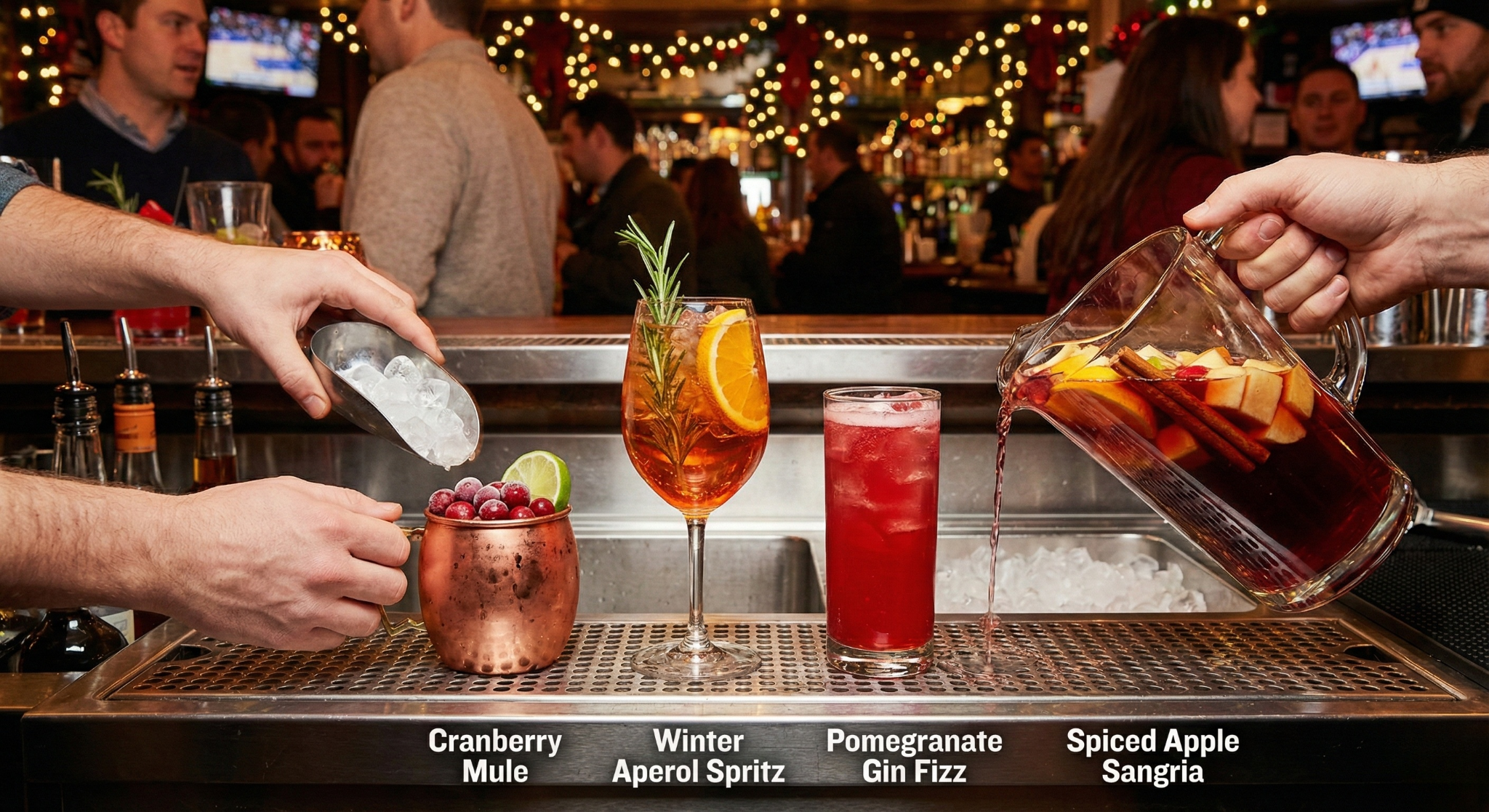
Designed for high-volume nights. minimal shaking, maximum speed.
5. Cranberry Mule: Vodka, lime juice, cranberry juice, topped with ginger beer. Garnish with frozen cranberries.
- Why it sells: It’s a twist on a familiar favorite. Staff can make it in 20 seconds flat.
6. Winter Aperol Spritz: Aperol, Prosecco, soda, but with a splash of cranberry and an orange slice/rosemary sprig.
- Why it sells: Spritzes are still trending. This "winterizes" a summer favorite without requiring new training for staff.
7. Pomegranate Gin Fizz: Gin, pomegranate juice, soda water.
- Why it sells: The deep red color looks incredibly festive, but the pour cost is low and the speed is high.
8. Spiced Apple Sangria (Batch Friendly): White wine, apple cider, cinnamon sticks, and diced apples.
- Why it sells: You can make 5 gallons before the shift starts. Zero bartending bottlenecks during the rush.
Category 3: The Social Media Stars

These take longer to make but command the highest prices. Use these to drive traffic.
9. Gingerbread Espresso Martini: The standard Espresso Martini (still the #1 cocktail in many cities) with a shot of gingerbread syrup and a cookie garnish.
- Why it sells: It combines the caffeine kick customers need for late-night shopping with holiday flavor.
10. Smoked Maple Old Fashioned: Bourbon, maple syrup, bitters, and wood smoke.
- Why it sells: The theater of the smoke. People film this drink being made, tag your location, and do your marketing for you.
11. The "White Christmas" Mojito: White rum, coconut milk, lime, mint, and pomegranate seeds (to look like mistletoe).
- Why it sells: It looks like snow in a glass. Visually stunning.
12. Champagne Cocktail with Cotton Candy: A glass of bubbly poured over a tuft of strawberry cotton candy.
- Why it sells: Interactive and fun. The cotton candy dissolves, changing the drink's color.
How to Use Your POS Data to Maximize Cocktail Revenue
Launching the menu is step one. Optimizing it is where the profit happens. You shouldn't be guessing which of these festive drinks ideas are working — your POS should tell you.
Here is how smart owners use systems like OneHubPOS during the holidays:
1. Identify Your "Menu Dogs" vs. "Stars"
By the end of week one in December, pull your Product Mix Report.
- The Goal: Find high-volume, high-margin drinks (Stars).
- The Action: If the Cranberry Mule is flying off the bar but the Smoked Old Fashioned is slowing down service and selling poorly, cut the Old Fashioned. Streamline the menu to support speed.
2. Track Modifications for Inventory
Are customers asking for "Titios" in their Cranberry Mule instead of the well vodka?
- The Goal: Understand upselling trends.
- The Action: If your modification reports show a preference for premium spirits, create a "Premium Holiday Menu" with higher price points to capture that revenue automatically without the bartender needing to ask.
Must Read: No more stockouts: Inventory management hacks for liquor stores.
3. Inventory Management for "LTO" Ingredients
Nothing kills a vibe faster than running out of peppermint schnapps on December 20th.
- The Goal: Prevent stockouts.
- The Action: Set low-stock alerts in OneHubPOS for your seasonal-only ingredients. Since you don't carry these year-round, it’s easy to forget to reorder them until it’s too late.
Retailers: How Liquor Stores Can Play This Game
If you own a liquor store, you aren't pouring these drinks, but you can still profit from them.
- Create "Recipe Bundles": Don't make the customer hunt for ingredients. Place a bottle of Kahlua, Vodka, and a bag of coffee beans together near the register with a sign reading "Everything you need for a Gingerbread Espresso Martini."
- Print Recipe Cards: Give away free cards with these festive drinks ideas when customers buy the base spirit. It adds value and encourages them to buy the mixers they might have skipped.
Final Thoughts: Pouring Profit This December
The holiday season is short. You have roughly four weeks to maximize this revenue spike.
Don't just throw recipes at the wall. Curate a menu of Christmas cocktails that balance flavor with speed, and keep a hawk-eye on your POS reports to see what’s actually moving the needle.
Is your POS ready for the holiday rush? OneHubPOS offers the granular reporting and inventory management you need to turn festive chaos into organized profit. Register for a free demo call to learn more about our restaurant & liquor Store Solutions here.
.png)

5 min read
Christmas season is loud on the outside — packed lines, bigger baskets, more promos, more delivery orders.
But the real story is quiet and internal: how your team feels between the rushes.
In both QSRs and liquor stores, holiday success isn’t just about staffing enough bodies.
It’s about protecting the people who already carry your business on their shoulders.
Because when morale slips in December, everything slips with it — speed, accuracy, guest experience, and the willingness to upsell.
And the scary part is, morale doesn’t usually crash with a bang. It fades with a shrug.
This blog gives you a practical, holiday-ready staff management system for QSRs and liquor stores, plus a simple way to configure your POS so your training sticks under pressure.
The 3 silent morale killers in QSRs during Christmas
These are “silent” because nobody files a formal complaint about them.
They just start showing up late, stop suggesting add-ons, or quietly disappear after New Year’s.
1) Scheduling chaos that feels personal
Holiday schedule problems don’t just upset employees — they change how employees interpret the job.
When shifts move last minute, or the same people are always asked to cover gaps, your best staff start thinking:
“Being good here just means I get punished with more responsibility.”
What helps immediately
A two-week schedule lock is simple but powerful.
Even if the schedule isn’t perfect, predictability rebuilds trust.
Also: build a small holiday bench — a couple of part-timers or cross-trained team members who want extra hours.
This removes the “panic call” culture that drains morale fastest.

2) Training debt disguised as “that’s just December”
The holiday season often adds LTOs, new bundles, new rush patterns, and new hires at the same time.
That’s not a training situation — that’s a training trap.
New staff feel overwhelmed.
Senior staff feel trapped in coaching mode.
The fix that actually fits real life
Use 5-minute micro-training before shifts.
A simple rhythm that works:
- 3 things to sell
- 3 ways to say it
- 3 rules for speed + accuracy

This is small enough to be consistent — and consistency is what makes holiday execution feel stable.
3) Recognition that rewards only the loudest winners
During December, fairness sensitivity rises.
People notice imbalance faster because the stakes are higher and the shifts are tougher.
If incentives only reward top sellers, you unintentionally punish steady performers who hold the line in chaos.
That’s how quiet resentment turns into quiet exits.
Better approach to manage employee incentives
Run a team-based holiday scoreboard focused on what actually keeps the store healthy:
- speed
- accuracy
- attach rate
- guest compliments
Reward “most improved” as much as top performers.
It keeps the team competing with yesterday instead of with each other.
How to train QSR staff to upsell during the holiday season (without sounding pushy)
Here’s the mindset shift that changes everything:
Holiday upselling is not selling. It’s helping.
Customers in December are often ordering for groups, gifting, or rewarding themselves.
They don’t need persuasion — they need a simple suggestion at the right moment.
The “Holiday 5” for QSRs
Pick five add-ons that are easy to ring and easy to recommend:
- seasonal beverage
- dessert
- premium side
- combo upgrade
- family pack
One-line scripts that feel natural
- “Want to make that a holiday combo?”
- “Add a dessert for the drive?”
- “This upgrade feeds the group faster.”
Short prompts reduce the emotional load on staff.
They don’t have to “think of a pitch.” They just have to remember one sentence.
Liquor store holiday morale is a different kind of pressure

Liquor retail adds two emotional weights that QSRs don’t face in the same way:
- Safety anxiety
- Compliance pressure
When a cashier is worried about theft or conflict, upselling feels like the last priority.
And when a new hire is nervous about ID mistakes during rush, confidence drops fast.
This means your holiday staff strategy must protect confidence as much as performance.
The Christmas season stress points in liquor stores
Safety stress
Holiday baskets are bigger, and the store environment gets more intense.
Even if incidents are rare, the feeling of risk is exhausting.
What helps: Clear coverage rules and visible manager support.
When possible, add two-person coverage for the highest-risk windows.
Compliance anxiety
Staff don’t want to be the person who “got it wrong” during a rush.
That fear is subtle — but it slows checkout and raises stress.
What helps: A standardized 30-second ID routine that everyone follows the same way.
Consistency reduces conflict and protects confidence.
SKU + gifting overload
Holiday shoppers ask rapid-fire questions:
“What’s a good gift under $40?”
“What pairs with this?”
“What’s a safe crowd-pleaser?”
Without a system, your staff becomes a search engine under pressure.
What helps: Simple gift and party bundles that staff can confidently recommend.
Liquor store holiday upselling that feels like service
The best liquor upsells are framed as hosting and gifting help.
The liquor “Holiday 5”
- premium mixers
- gift packs
- snack pairings
- mini add-ons
- party bundles
One-line scripts
- “Hosting tonight? This mixer pairs perfectly.”
- “Want a quick gift option? This pack is a favorite.”
- “These snacks go great with that bottle.”
Your staff shouldn’t need product encyclopedias in their head.
They should need 5 easy answers they can repeat all month.
BOFU decision: Bundle-first vs brand-first holiday merchandising
This might look like a marketing decision.
But it’s also a staff management decision.
Bundle-first merchandising
You lead with occasions:
“Gifts Under $40,” “Host-Ready Cocktail Kit,” “Game Night Pack.”
This is a holiday powerhouse because it reduces decision fatigue — for customers and staff.
It provides a script your team can repeat without thinking too hard during rush.
Brand-first merchandising
You lead with premium labels and trust-based buying.
This shines when you have brand-savvy customers and confident staff who can tell a quick story. It also helps drive premium trade-ups.
The hybrid that usually wins
Use bundle-first to speed up holiday gifting and party decisions.
Use brand-first to create a premium upgrade layer.
This keeps your store fast and aspirational.
The quiet performance multiplier: POS setup that reinforces your holiday plan
Training fades when the store gets chaotic.
But a well-structured POS keeps your team on rails.
That’s why your holiday staff strategy should include a simple POS alignment step.
What to configure for QSRs
- Holiday 5 pinned to fast-access buttons
- combo shortcuts
- modifier presets
- consistent layout across terminals
When the same five upsells appear on the screen every day, staff stops relying on memory.
Speed improves, stress drops, and upselling feels automatic.
What to configure for liquor stores
- barcode-first checkout flow
- Holiday 5 quick add-on buttons
- clear category tiles for faster discovery
- standardized register layout across shifts
This is especially helpful for seasonal hires.
The more your POS guides them, the less your senior employees have to babysit the counter.
Where OneHubPOS fits naturally
OneHubPOS supports this approach because it’s built for standardized, flexible workflows:
- Android-based and fast to deploy across common counter setups
- Processor-agnostic, which lets you improve operations without a forced payments switch
- Menu and item organization that can be aligned to your Holiday 5 strategy
- Multi-terminal consistency so every shift sees the same operational logic
The real benefit is emotional, not just technical:
Your team feels like the system is helping them instead of testing them.
Your holiday staff management formula (simple, repeatable, calm)
If you want one clean operating principle for December, use this:
Predictability + micro-training + POS reinforcement.
That trio protects morale and protects revenue.
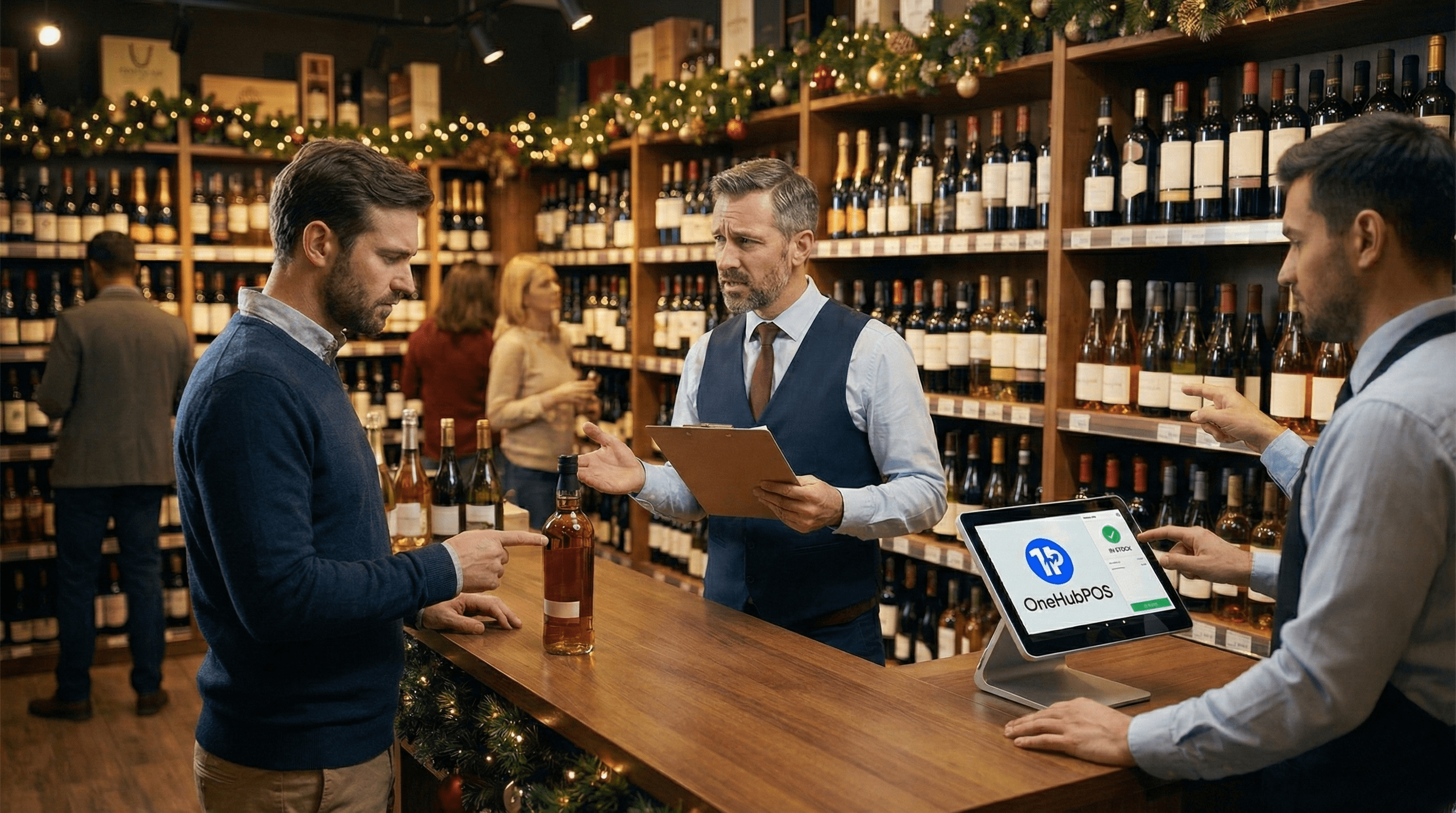

5 min read
Holiday demand hits liquor stores fast, and unforgivingly. One missed reorder can mean empty shelves, lost sales, and customers who don’t come back.
When demand spikes overnight, traditional liquor store inventory management methods fall short. Real-time tracking becomes essential, not optional.
In this guide, we break down how to manage liquor store inventory during the holiday rush and how liquor-specific POS systems help you stay stocked, compliant, and profitable during peak season.
See Also: Meet the AI Inventory System Built for American Retailers
Why Holiday Inventory Is a Make-or-Break Moment for Liquor Stores
The holiday season isn’t just “busy.” It’s unpredictable.
- Sudden spikes in demand for specific SKUs
- Customers buying in bulk for parties
- Gift purchases replacing regular buying patterns
- Distributors facing their own supply constraints
A single missed reorder can mean:
- Lost high-margin sales
- Customers switching stores (and not coming back)
- Overbuying slow-moving stock to “play it safe”
This is why liquor store inventory management during holidays requires precision, not guesswork.
Common Holiday Inventory Mistakes Liquor Stores Make
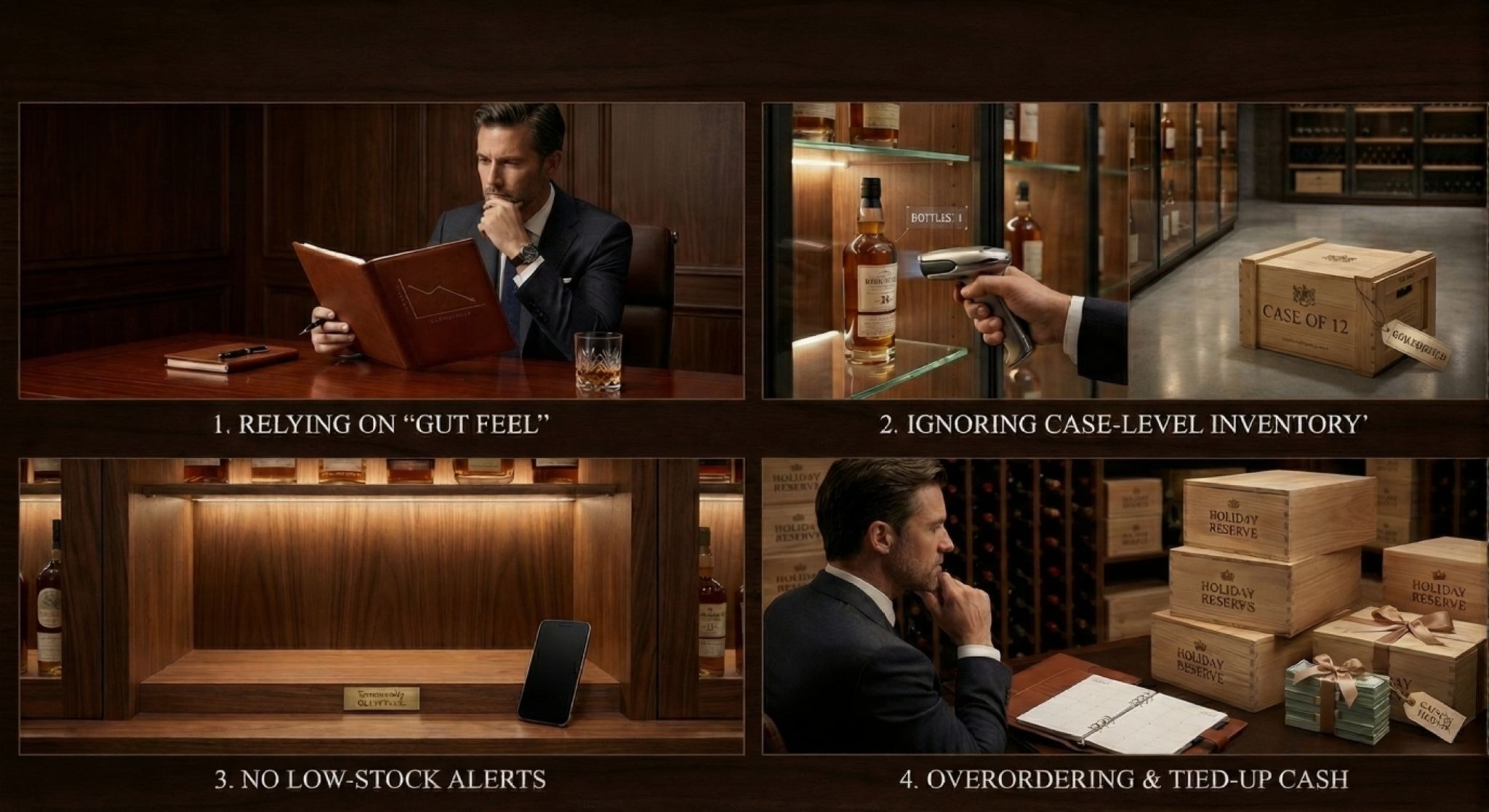
Before we talk about solutions, let’s call out the usual culprits.
1. Relying on “gut feel” instead of real-time data
Manual counts, spreadsheets, or end-of-day reports lag behind reality — especially during high-volume days.
2. Tracking bottles but ignoring case-level inventory
Liquor stores don’t just sell units — they receive, split, and restock cases. Missing this layer creates blind spots.
3. No low-stock alerts
You realize you’re out after the shelf is empty — not before.
4. Overordering to avoid stockouts
This leads to tied-up cash, excess inventory, and compliance headaches post-holidays.
Sound familiar? You’re not alone.
What Smart Liquor Store Inventory Management Looks Like
Effective liquor store inventory management during peak seasons comes down to visibility, automation, and control.
Here’s what top-performing liquor stores do differently.
1. Track Inventory in Real Time. Not After the Fact
During the holidays, inventory changes every minute.
A liquor-first POS like OneHubPOS updates stock levels instantly with every sale — so you always know:
- What’s selling fast
- What’s about to run out
- What’s moving slower than expected
No overnight surprises. No blind replenishment.
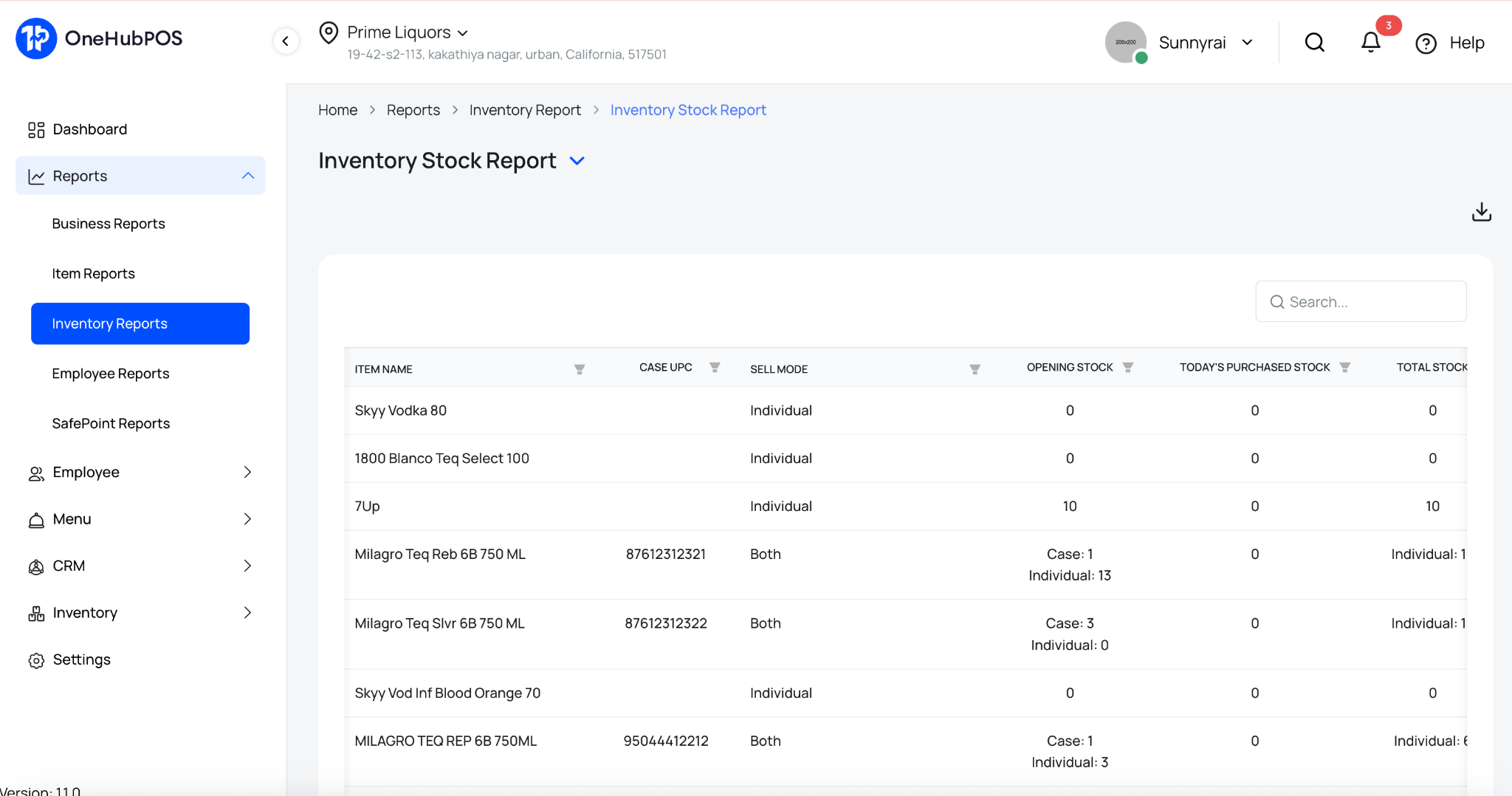
2. Manage Inventory by Case, Bottle, and SKU
Liquor inventory isn’t simple retail inventory.
You need visibility across:
- Case stock
- Loose bottles
- High-SKU catalogs (often 5,000–15,000 items)
Modern liquor store inventory systems like OneHubPOS automatically adjust counts when cases are broken, transfers happen, or partial stock is sold, without manual math.
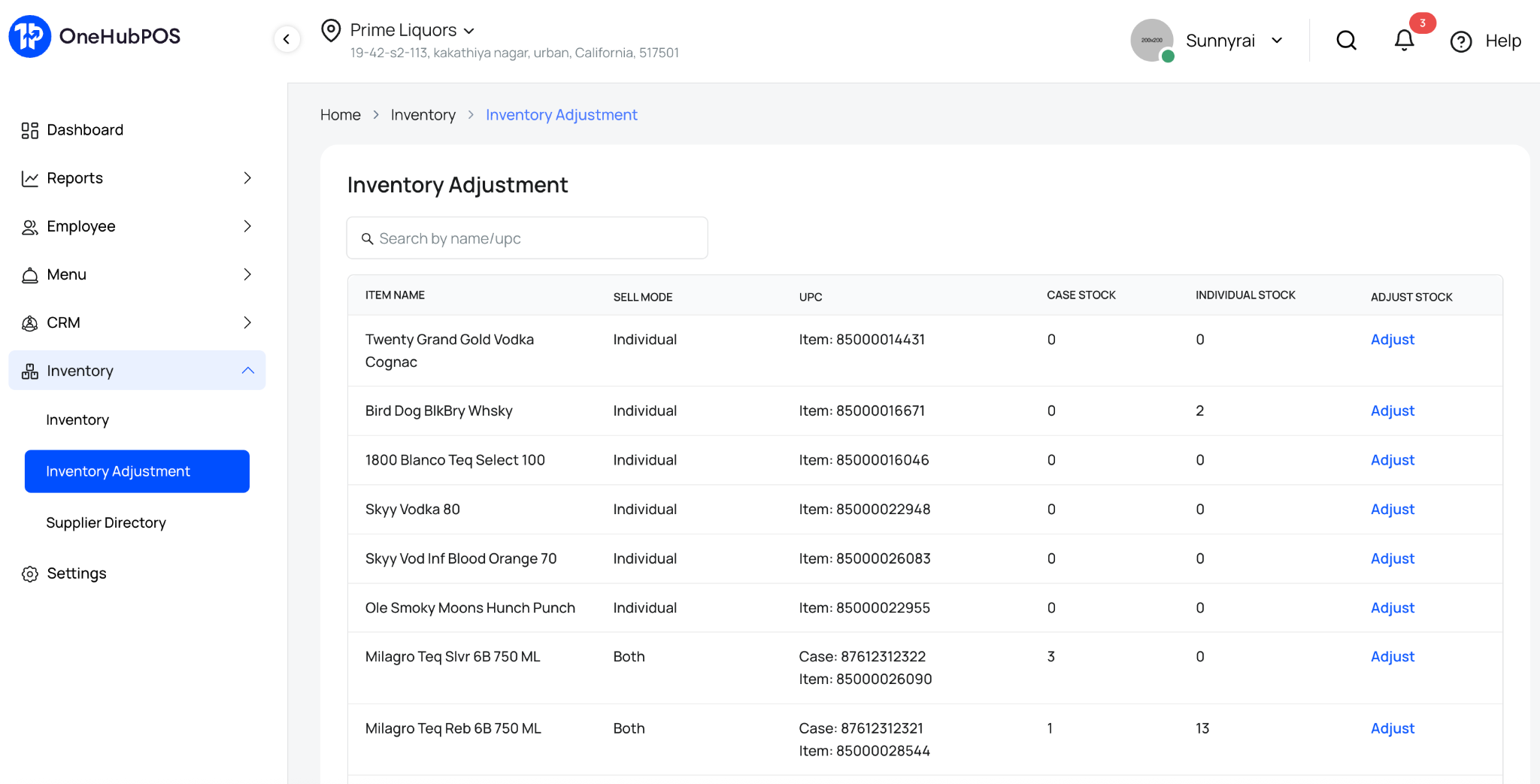
3. Set Smart Reorder Thresholds Before the Rush
The best time to prevent a stockout is before it happens. Modern liquor-centric POS systems like OneHubPOS support item-level reordering thresholds which ensure:
- Your POS alerts you when stock hits a predefined level
- Fast-moving holiday SKUs get reordered on time
- Slow movers don’t clog your shelves
This balance is critical during festive demand spikes.
4. Track What Actually Drives Holiday Revenue
Not all liquor sells equally during the holidays. Your inventory system should clearly show:
- Top-selling brands and categories
- Seasonal spikes (tequila, champagne, premium whiskey, etc.)
- Margin-heavy SKUs worth prioritizing
This insight lets you stock smarter, not just more.
5. Stay Compliant While Scaling Sales
Holiday chaos shouldn’t put your license at risk. A strong liquor store inventory management system like OneHubPOS includes:
- Clean audit trails
- Accurate purchase and sales records
- Support for state and local compliance requirements
When inventory is tracked properly, compliance becomes automatic, not stressful.
Why Generic POS Systems Fall Short for Liquor Stores
Many POS systems treat liquor stores like any other retail business. And that’s the problem.
Liquor stores face:
- Complex inventory structures
- High SKU counts
- Strict regulatory oversight
- Case-to-unit conversions
- Thin margins that punish mistakes
A liquor-first POS is built specifically to handle these realities — especially during peak seasons like the holidays.
How OneHubPOS Helps Liquor Stores Avoid Holiday Stockouts
OneHubPOS is designed specifically for liquor stores, not adapted as an afterthought.
With OneHubPOS, liquor store owners get:
- Real-time inventory tracking across bottles and cases
- Item-level low stock alerts to prevent sellouts
- High-SKU performance built for liquor catalogs
- Accurate reporting for smarter reordering decisions
- Compliance-ready records without extra effort
The result? Fewer stockouts. Better cash flow. More sales during the busiest season of the year.
Final Thought: Inventory Is Your Holiday Advantage
During the holidays, customers won’t wait and they won’t come back if you’re out of stock.
The difference between a chaotic season and a profitable one often comes down to how well you manage your inventory.
With the right liquor store inventory management system in place, you don’t just survive the holiday rush, you capitalize on it.
And when your shelves stay full while others run empty, customers notice.
Looking to tighten your liquor store inventory before the next surge? A liquor-first POS like OneHubPOS can make the difference between missed sales and record-breaking holidays. Book a 30-minute free demo call with a POS expert to understand what a liquor-centric POS can do for your business.


5 min read
The holiday season is the most lucrative time of year for beverage programs. Guests are not just looking for a meal; they are looking for "cheer." They are more willing to splurge on premium spirits, second rounds, and dessert drinks than at any other time of year.
Planning to keep you restaurant open this Christmas? Here's what you need to know.
If you are still running your standard drink menu in December, you are leaving money on the table. A dedicated seasonal menu featuring Christmas cocktails creates urgency, increases check averages, and offers free marketing when guests snap photos of your beautiful creations.
Here are 12 profitable, crowd-pleasing holiday drinks to add to your menu this season to keep spirits, and sales, high.
Also Read: Top 10 Menu Ideas for Cafes to Crush the Holiday Rush
The "Nostalgia" Drivers (Creamy & Sweet)
These drinks appeal to guests looking for comfort. They often replace dessert, allowing you to capture that final $12–$15 add-on at the end of a meal.

1. The Gingerbread Martini
Turn the season’s favorite cookie into a high-margin cocktail.
- The Mix: Vodka, Baileys, and gingerbread syrup.
- The Upsell: Rim the glass with crushed ginger snaps and top with a dollop of whipped cream.
- Why it sells: It sounds like a dessert but drinks like a martini. It’s the perfect "liquid dessert."
2. Peppermint White Russian
A minty twist on "The Dude’s" favorite drink.
- The Mix: Vodka, coffee liqueur, peppermint schnapps, and heavy cream.
- The Presentation: Serve with a mini candy cane hanging off the side.
- Why it sells: It’s visually iconic. The red-and-white candy cane garnish signals "Christmas" immediately to anyone looking around the dining room.
3. House-Made Spiked Eggnog
Store-bought eggnog has a bad reputation, but house-made eggnog is a premium luxury.
- The Mix: Bourbon or dark rum, cream, sugar, eggs, and fresh nutmeg.
- The Twist: Offer a "flight" of eggnogs (e.g., one bourbon, one rum, one tequila-based) to increase ticket size.
- Why it sells: It screams tradition. Marketing it as "made from scratch in-house" justifies a higher price point.
The "Batch-Ready" Profit Makers (Fast & Efficient)
Speed of service is critical during the holiday rush. These holiday drinks can be pre-batched before the shift, allowing your bartenders to pour and serve in seconds.
4. Classic Mulled Wine
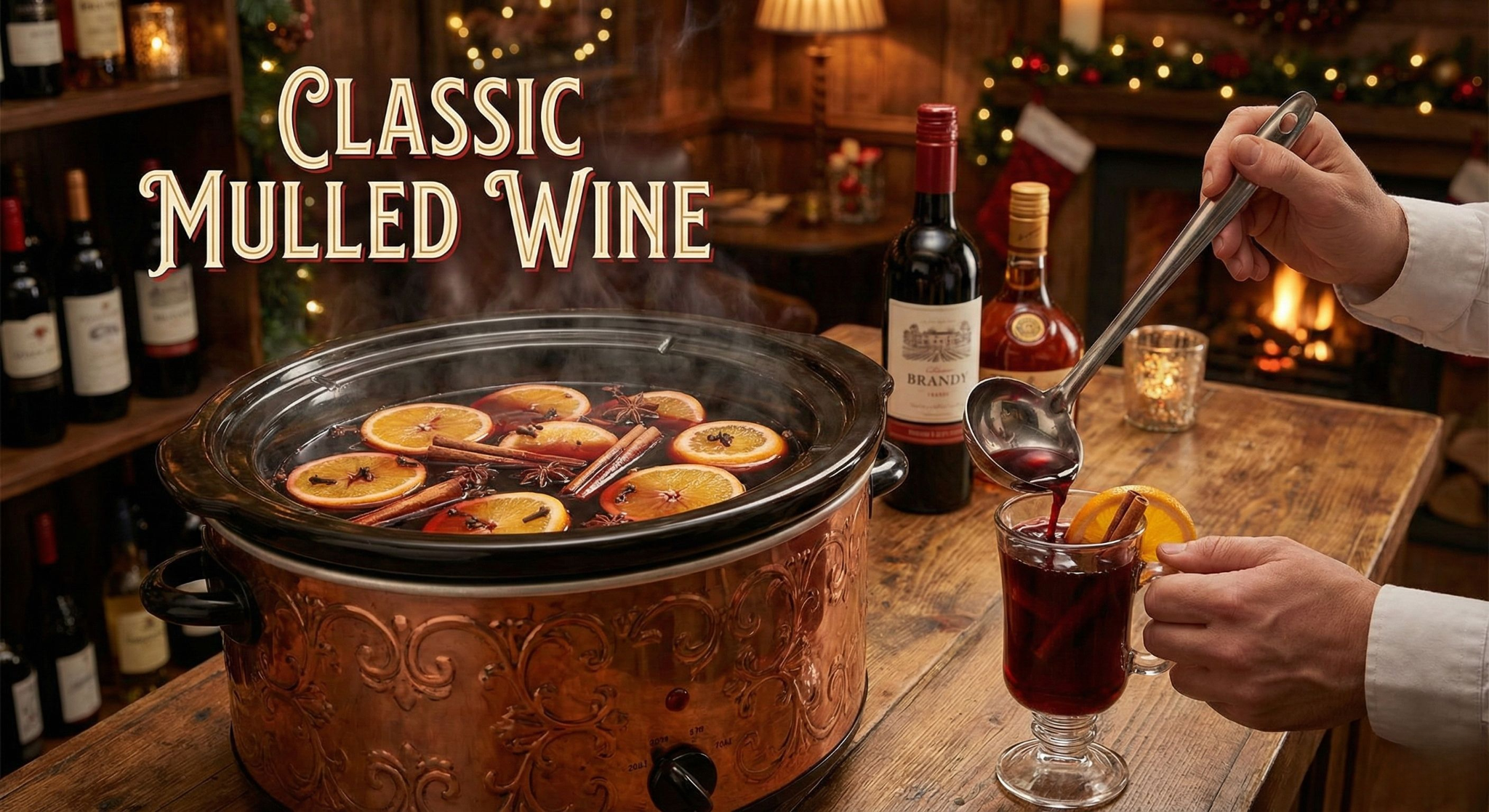
The ultimate high-margin winter warmer.
- The Mix: Red wine (use a cost-effective bulk wine), brandy, oranges, cinnamon sticks, cloves, and star anise.
- The Operation: Keep it warm in a slow cooker or urn behind the bar. The smell alone will sell it to guests walking through the door.
- Why it sells: It’s an impulse buy driven by aroma.
5. Cranberry Mule (The "Yule Mule")
A festive spin on the vodka staple that requires zero new training for staff.
- The Mix: Vodka, ginger beer, lime juice, and a splash of unsweetened cranberry juice.
- The Garnish: Fresh rosemary sprig and frozen cranberries.
- Why it sells: Mules are already best-sellers. The color change (red) and the name change make it feel seasonal without scaring off customers who want something familiar.
6. Winter Sangria
A lighter option for lunch crowds or large groups.
- The Mix: Red wine, pomegranate juice, triple sec, and slices of winter citrus (blood oranges, grapefruits) and pears.
- Why it sells: Pitcher sales. This is the perfect drink to suggest to a table of four, instantly boosting the beverage sale by $40–$50 in one command.
The "Instagram" Sparklers (Elegant & Fizzy)
These Christmas cocktails are designed to look beautiful. They are perfect for toasts, celebrations, and social media shares.
7. Pomegranate Rosemary Royale
A sophisticated upgrade to the Kir Royale.
- The Mix: Prosecco or Champagne topped with a splash of pomegranate liqueur.
- The Garnish: A single sprig of rosemary. The bubbles cling to the rosemary needles, looking like a Christmas tree covered in snow.
- Why it sells: It looks high-end but has a low liquor cost (mostly sparkling wine).
8. The "Grinch" Mimosa
A bright green cocktail that is fun and playful.
- The Mix: Sparkling wine mixed with melon liqueur (Midori) or green juice (for a healthier vibe), topped with a red cherry.
- Why it sells: The color is shocking. It stands out on tables and encourages people to ask, "What is that?"
9. Spiced French 75
- The Mix: Gin, lemon juice, Champagne, and a house-made cinnamon-clove syrup instead of simple syrup.
- Why it sells: It transforms a sophisticated classic into a warm, spiced holiday favorite.
The "Cold Night" Warmers (Hot Drinks)
If your restaurant is in a cold climate, these are mandatory.
10. Hot Buttered Rum
- The Mix: Dark rum, boiling water, and a "batter" of butter, brown sugar, and spices.
- The Secret: Make the butter batter in bulk. All the bartender has to do is add a scoop of batter to rum and water.
- Why it sells: It’s rich, warming, and feels like a hug in a mug.
11. Boozy Mexican Hot Chocolate
- The Mix: Hot chocolate, tequila or mezcal, and a pinch of cayenne pepper.
- The Rim: Cinnamon sugar and chili powder.
- Why it sells: The spicy kick makes it memorable and distinguishes it from a kid’s drink.
12. The Smoked Maple Old Fashioned
For the serious drinker who doesn't want cream or bubbles.
- The Mix: Bourbon, maple syrup (instead of sugar), walnut bitters, and a smoked glass presentation.
- Why it sells: It’s theatrical. If you smoke the glass at the table or bar, the visual performance justifies a premium price (e.g., $18+).
Quick Tips for Launching Your Holiday Menu
- Print a Separate Insert: Don't bury these Christmas cocktails in your main menu. evocative descriptions on a small card clipped to the menu work best.
- Mocktail Options: Ensure at least two of these (like the Mule or the Hot Chocolate) have a "zero-proof" version available. Non-drinkers want to feel festive, too.
- Use What You Have: You don’t need to buy 20 new spirits. Most of these rely on syrups (gingerbread, cinnamon, peppermint) which are cheap to make or buy, rather than expensive new liquors.
By introducing these holiday drinks, you aren't just selling alcohol; you are selling the holiday spirit. Cheers to a profitable December!
Ready to launch your holiday menu? Ensure your operations are smooth and your inventory is accurate this season with OneHubPOS. Book a free demo today to see how our software helps you manage the holiday rush with ease.
![How to Customize Your QSR Menu on Your POS for Seasonal Promotions [Holidays 2025 Edition]](https://cdn.prod.website-files.com/653392c432e997a1c5316037/67a0a882eb8117e84eb84a31_94752%20(1).webp)
![How to Customize Your QSR Menu on Your POS for Seasonal Promotions [Holidays 2025 Edition]](https://cdn.prod.website-files.com/653392c432e997a1c5316037/6745bc60711db09281a43786_Screenshot%202024-11-26%20at%205.45.59%E2%80%AFPM.png)
5 min read
As we approach the 2025 holiday season, nothing draws a crowd quite like a limited-edition peppermint mocha or a festive winter feast combo. These seasonal items have the power to pique customer curiosity and drive repeat visits.
However, effectively managing seasonal promotions involves more than just adding new items to your menu. To increase sales and stay ahead of competitors, you need a system that tracks sales trends during promotions and helps you adjust offers in real time based on their performance.
The well-customized OneHubPOS systems don’t just take orders. They help you analyze customer behavior, fine-tune your promotions, and manage inventory. Let’s break down how you can use your POS to run successful seasonal promotions that actually give you results.
Interesting Read: Planning to keep your restaurant open this Christmas? Here's what the data says.
Why Seasonal Promotions Are a Big Deal for QSRs
If you’ve ever noticed a spike in sales around the holidays in your quick service restaurant, you’re not imagining things.
Did You Know?
Dining out experiences a significant spike in demand during the holiday season. Restaurant spending grew by 6.3% compared to the previous year, with an increased preference for mobile ordering, curbside pickup, and delivery options.
But Why Should You Care?
Starbucks excels every holiday season with its iconic holiday cups and handcrafted beverages like the Caramel Brulée Latte and Chestnut Praline Latte. They’re limited, they’re iconic, and they get people through the doors (or on the app) every year.
So, here’s what seasonal promotions can do:
- Limited-time offers create urgency, encouraging customers to act quickly and order more before time runs out.
- Seasonal menus get people talking, sharing on social media, and returning to try new items.
- Everyone loves a good festive twist. Promotions give you an edge over competitors not offering anything special.
Top 8 POS Reports Every QSR Owner Needs for Seasonal Promotions
Data is your best friend during seasonal promotions. To really crush your seasonal campaigns, you need to get deeper into your restaurant POS reports. It shows you what’s working, what’s not, and how to improve in real-time. Here's a breakdown of the most valuable restaurant analytics reports in your handheld POS system and how they can help you supercharge your seasonal marketing.
1. Restaurant Sales Report
Compare your seasonal sales against the same period last year to see growth patterns for your QSR. This report gives you the big picture using relevant parameters like gross sales, net sales, discounts, shipping, tax, order tips, product discounts, cash discounts, and refunds:
- How much revenue your seasonal items are bringing in
- Whether your seasonal discounts are actually increasing sales or just cutting into profits
- Sales performance during specific time periods, like weekends and holidays

2. Day Wise Report
Ever noticed how some days just feel busier? This report breaks it down for you.
- See which days bring the most traffic during a seasonal campaign.
- Identify slower days and consider running mid-week offers.
So, if Fridays show the highest seasonal dessert sales, you could launch a “Festive Friday” deal with double points on all dessert orders.

3. Day End Report
A daily summary provides insights into your seasonal menu’s performance, allowing you to identify trends and refine offers for the following day. This report gives you:
- Total sales
- Payment types, like contactless or cash
- Cash in hand

4. Order History Report
This report tracks every transaction during your seasonal promotion using parameters like items, quantity, menu price, selling price, item-wise tax, item-wise discount, upsell items, service charge, packing charge, and delivery charge.
- See which seasonal items were ordered most often.
- Identify which items you can upsell along with holiday essentials.

5. Order Type Report
Some customers prefer dining in, while others lean towards takeout or delivery. This report breaks down:
- How many orders were dine-in, takeaway, or delivery
- Seasonal item popularity across different order types
- Discounts and refunds
- House credit
You can create exclusive promotions for each type, such as “Get a free drink with your holiday burger – delivery only!”

6. Product Report
This is your go-to report for checking how well individual seasonal items are performing. It includes parameters like product name, barcode, quantity sold, percentage of quantity sales, gross sales, and percentage of gross sales. With this report, you can find out:
- Which seasonal dishes are best-sellers?
- Are some items underperforming and need a discount boost?
You can use this data to retire underperforming items or modify the recipe to match customer preferences better.

7. Inventory Stock Report
This report helps you avoid the classic holiday mistake: running out of your star item. It takes into account product names, barcodes, SKUs, opening stock, current day’s purchased stock, total stock, total sold quantity, current stock, and price. This way, you can:
- Monitor stock levels for seasonal ingredients.
- Set automatic restock alerts for critical items.
Pro-tip: Use inventory reports to adjust your promotional timeline if stock is running low.

8. Employee Reports
Promotions often mean longer hours and extra staff. These reports help you manage labor costs and productivity.
- Track extra hours worked during the seasonal rush.
- Identify top-performing employees with net sales data.
- Keep track of how many hours worked and tips earned.
Pro-tip: Offer a small bonus or incentive for staff who upsell seasonal combos the most.


Ease Up Seasonal Promotions with OneHubPOS Seasonal promotions have the power to boost sales, create buzz, and bring new customers through your doors. But to really make them work, you need OneHubPOS to launch promos and give you the insights to keep improving them. Using its POS analytics reports allows you to tweak and optimize promotions for better results. Ready to transform your seasonal campaigns with OneHubPOS? Book a free demo today and discover how data-driven insights can elevate your promotional strategy!


5 min read
Every year, as the calendar turns to December, restaurateurs face the same high-stakes dilemma: Should we keep the lights on for Christmas Eve and Christmas Day?
It is a decision that pits potential profit against employee morale, and operational headaches against brand loyalty. For years, this choice was driven by gut feeling or tradition. But today, we have data, real numbers on consumer spending, staffing trends, and market demand, that can turn this emotional debate into a calculated business decision.
Below, we break down the statistics to help you decide if your restaurant should be serving holiday feasts or taking a well-deserved winter’s nap.
See Also: Top 10 Holiday Menu Ideas for Cafes to Crush to Holiday Rush

The Case for Opening: The Revenue Opportunity
The narrative that "everyone eats at home on Christmas" is outdated. Recent trends suggest a massive shift in consumer behavior, driven by convenience, changing demographics, and a desire to escape the kitchen.
1. The Demand is Higher Than You Think
The National Restaurant Association has reported startling figures in recent holiday seasons. Their data indicates that roughly 57% to 77% of consumers plan to let restaurants handle their cooking during the holidays, whether through dining in or takeout.
- The "Convenience" Factor: 82% of consumers cite stress reduction as their primary reason for dining out on holidays.
- The "Burnout" Factor: After Thanksgiving, many home cooks are fatigued. By Christmas, the appetite for scrubbing pots and pans plummets, creating a surge in demand for full-service dining.
2. The "Blue Ocean" Advantage
While demand is high, supply is often low. Data from OpenTable suggests that a significant portion of independent restaurants close on Christmas Day.
- Market Share: If 60% of your competitors are closed, the remaining 40% absorb 100% of the dining demand.
- Visibility: Being one of the few options available boosts your SEO and discovery. Queries for "restaurants open on Christmas near me" spike dramatically on December 24th and 25th.
3. Higher Check Averages
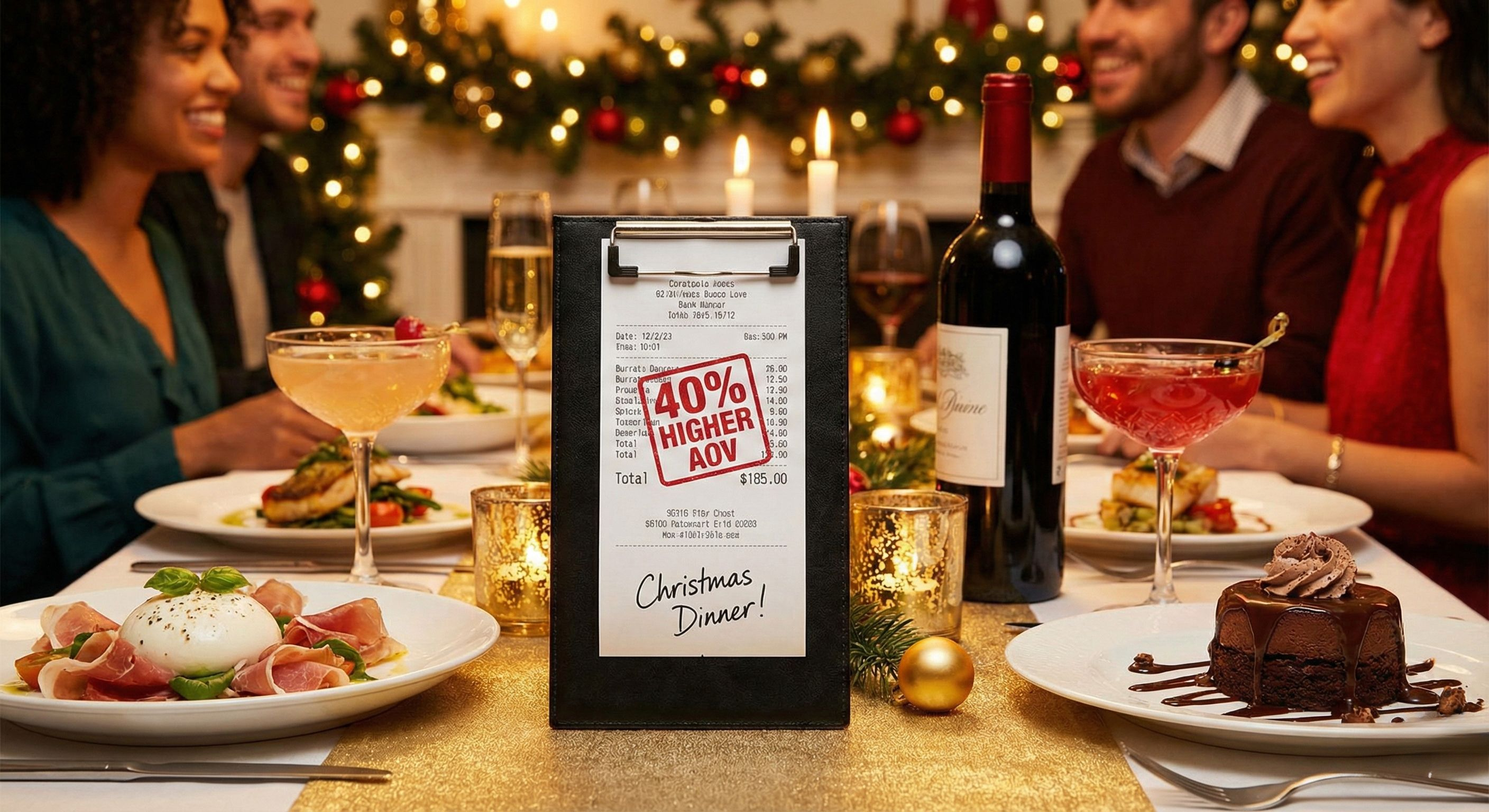
Christmas diners are not looking for a quick bite; they are looking for an experience. Data has shown that while overall transaction counts might dip compared to a standard Friday night, the Average Order Value (AOV) often skyrockets—sometimes by 40% or more.
- Why? Holiday diners are less price-sensitive. They order alcohol, appetizers, and desserts. They are there to celebrate, meaning the "per-head" revenue is significantly higher than a typical service.
4. Niche Cuisines Thrive
If your concept falls into specific categories, opening is almost a guaranteed win. Historical data shows that Asian cuisine (particularly Chinese and Indian) and Hotel Restaurants see massive spikes in traffic on Christmas Day.
- The Cultural Staple: For many Jewish families and those who do not celebrate Christmas religiously, dining at a Chinese restaurant is a beloved tradition. If you operate in this niche, closing is leaving significant money on the table.
The Case for Closing: The Operational Reality
Despite the revenue potential, the data also supports a strong argument for closing. It’s not just about being "nice"; it’s about long-term sustainability and labor economics.
1. The "Ghost Town" Risk for General Concepts
While AOV goes up, overall traffic volume can be volatile. Data in past years has shown that for general American dining concepts, sales on Christmas Day can be up to 84% lower than the average December day.
- The Risk: If you are a casual burger joint or a sandwich shop, you may not attract the "celebratory" crowd. You risk paying holiday labor rates for a dining room that sits empty.
2. The Staffing Crisis & Labor Costs
Labor is the single biggest hurdle.
- The Cost of "Yes": To convince staff to work Christmas, you often need to offer double time or significant bonuses. If your labor cost percentage usually sits at 30%, it could easily balloon to 45-50% on Christmas Day.
- The "Great Resignation" Hangover: In a tight labor market, employee retention is gold. Forcing staff to work major holidays is a leading cause of burnout and turnover. The cost of recruiting and training a replacement (often cited as $2,000 - $5,000 per employee) far outweighs the profit from one single day of service.
3. Reputation and Brand Perception
There is a growing consumer sentiment that values businesses that prioritize employee well-being.
- The "Good Guy" Bonus: Announcing that you are "Closed to let our team be with their families" generates positive social media engagement. It builds goodwill that pays dividends in January and February, notoriously slow months where you need local loyalty the most.
Strategic Decision Framework: How to Decide
Don't guess. Use this three-step framework to analyze your specific situation.
Step 1: Analyze Your Location Data
- Urban vs. Suburban: OpenTable data reveals that urban centers maintain about 40% restaurant availability on Christmas, whereas suburban areas drop to 12%.
- If you are in a city center: Open. You have a captive audience of tourists, travelers, and locals.
- If you are in the suburbs: Close. Your customer base is likely at home with family.
Step 2: Survey Your Staff (The "Veto" Vote)
Before you look at a P&L, look at your roster. Conduct an anonymous survey in October or November.
- Question: "Would you be willing to work Christmas Day for [Insert Incentive: e.g., Double Pay + $50 Bonus]?"
- If less than 60% of your core team says yes, close. Forcing the issue will breed resentment that rots your culture from the inside out.
Step 3: Check Your Historical Data
If you have been open previously, pull your POS reports.
- Look at Labor Cost Percentage for December 25th specifically.
- Did you break even? Did you make a profit?
- Pro Tip: If you only broke even, it wasn't worth it. The operational stress requires a healthy profit margin to justify the day.
If You Do Open: The Playbook for Success
If the data says "Go," do not treat Christmas like a normal Tuesday. You must operationalize differently to ensure profitability and staff happiness.
- Ticketed Events Only (Or Deposits):
- Use a reservation system like Tock or OpenTable to require a deposit. No-show rates can be erratic on holidays. A $25-$50 per person deposit ensures that if you staff up, the revenue is guaranteed.
- Prix Fixe Menus are Mandatory:
- Do not run your full à la carte menu. Offer a 3-course set menu.
- Why? It streamlines kitchen operations, reduces food waste, allows you to run with a smaller back-of-house crew, and guarantees a high check average.
- Limited Hours:
- Open for a specific window (e.g., 12:00 PM – 6:00 PM). This captures the main demand but allows your staff to get home for a late dinner with their own families.
- Aggressive Marketing:
- Update your Google Business Profile immediately. The #1 frustration for holiday diners is driving to a restaurant that says "Open" on Google, only to find the doors locked.
- Promote your "Pre-Order Takeout" heavily. Many families want the food but not the dining room experience. This is high-margin revenue with lower labor costs.

The Verdict
Should you open?
- YES, IF: You are in a high-foot-traffic city, near hotels, offer Asian cuisine, or have a staff that is eager for overtime pay.
- NO, IF: You are a casual concept in the suburbs, your staff is burned out, or your historical data shows slim margins on holidays.
The days of opening "just in case" are over. Use the data, talk to your team, and make the choice that ensures your restaurant — and your people — prosper in the New Year.


5 min read
It’s mid-December. The streets are freezing, the shopping malls are chaotic, and your customers are exhausted. They aren't looking for a three-course meal; they are looking for a micro-escape. They want 15 minutes of warmth, a sugar hit, and a reason to smile.
For cafes, the holiday season is the ultimate playing field. While restaurants fight for expensive dinner reservations, cafes thrive on the "Lipstick Effect"—the economic theory that consumers still buy affordable luxuries even when money is tight. A $6.00 Gingerbread Latte is that affordable luxury.
If your menu still looks the same in December as it did in July, you are leaving thousands of dollars on the table. The "Golden Quarter" belongs to the coffee shops that embrace the festive spirit. But throwing a candy cane in a cup isn't enough. You need a strategy that balances speed, aesthetics, and nostalgia.
Here are the top 10 Christmas menu ideas specifically curated for cafes, coffee shops, and bakeries, designed to drive foot traffic and skyrocket your average ticket size.
Interesting Read: Should you keep your restaurant open on Christmas Day and Christmas Eve?
Category 1: Liquid Profits (High-Margin Signature Drinks)
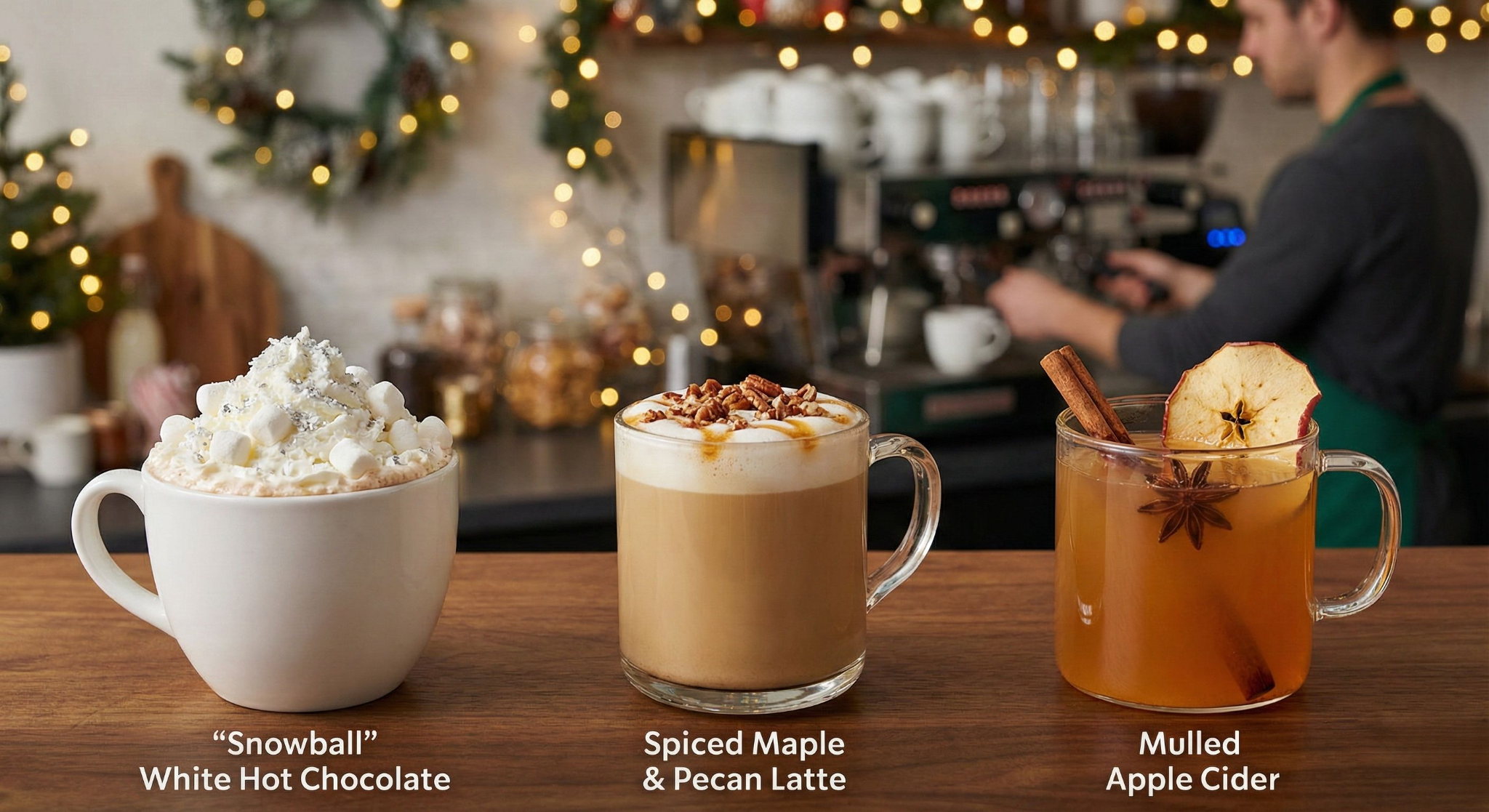
In a cafe, liquids are your financial backbone. Holiday drinks are the easiest way to upsell. They require zero kitchen prep time, just a well-trained barista and the right syrups.
1. The "Snowball" White Hot Chocolate
Classic hot cocoa is fine, but white chocolate feels rarer and more indulgent—perfect for the holidays.
- The Concept: High-quality white chocolate sauce steamed with milk (or oat milk for a creamy vegan option), topped with a mountain of whipped cream, mini marshmallows, and a dusting of edible silver glitter or coconut flakes to mimic snow.
- Why It Wins: It is visually striking. The "all white" aesthetic stands out on Instagram feeds dominated by red and green. It appeals heavily to non-coffee drinkers and children, making your cafe a destination for families shopping nearby.
- Barista Tip: Pre-rim your takeout cups with vanilla frosting and coconut shavings for speed during the rush.
2. The Spiced Maple & Pecan Latte
Move over, Pumpkin Spice. By December, customers are ready for deeper, nuttier flavors.
- The Concept: A double shot of espresso, maple syrup (real maple, not flavored corn syrup, makes a huge marketing difference), and a dash of pecan bitters or syrup. Finish with a sprinkle of roasted pecan crumb on the foam.
- Why It Wins: It feels sophisticated. While gingerbread and peppermint are fun, maple and pecan appeal to the adult palate looking for a "comfort" coffee that isn't sickly sweet. It pairs exceptionally well with pastries, encouraging food attachment.
3. Mulled Apple Cider (The Coffee Alternative)
Not everyone wants caffeine at 4 PM. A warm, fruit-based option is essential for the late-afternoon crowd.
- The Concept: Unfiltered apple juice simmered (or steamed to order via the wand) with cinnamon sticks, star anise, and orange peel. Serve it with a dehydrated apple slice garnish.
- Why It Wins: The aroma. Steaming apple cider releases a scent that fills the entire cafe, acting as olfactory marketing to anyone who walks through the door. It’s also gluten-free and dairy-free by default, making it a safe haven for customers with dietary restrictions.
Category 2: The Pastry Case (Impulse Buys)
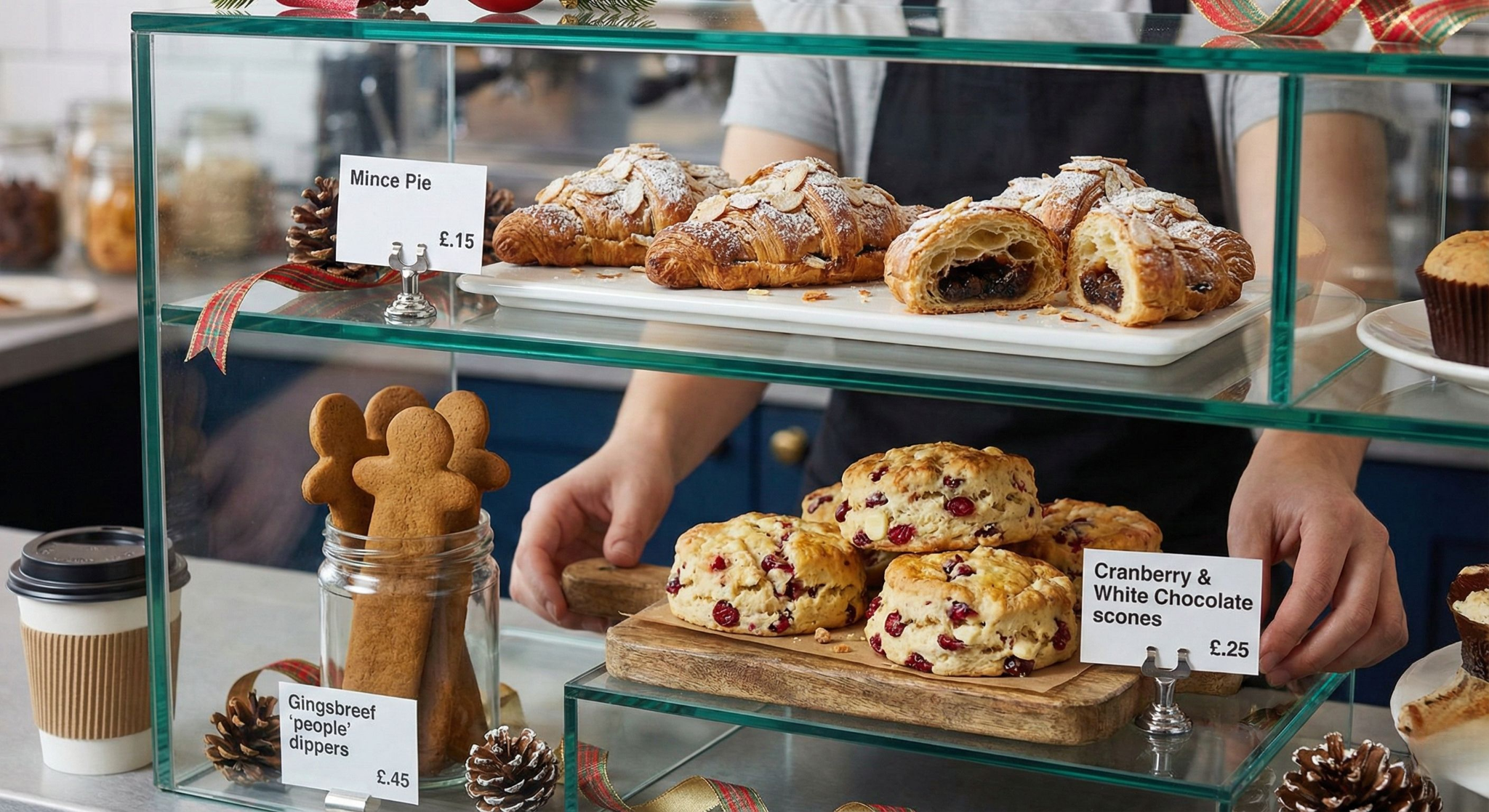
Your display cabinet is your silent salesperson. These Christmas menu ideas are designed to be grabbed impulsively while waiting for coffee.
4. The "Mince Pie" Croissant
Fusion pastries are trending globally. This takes a polarizing British classic (the mince pie) and wraps it in a universally loved vessel (the croissant).
- The Concept: A standard butter croissant filled with spiced fruit mincemeat (raisins, currents, nutmeg, cinnamon) and topped with flaked almonds and a dusting of icing sugar.
- Why It Wins: It solves the "dry pastry" problem. The mincemeat keeps the croissant moist from the inside out. It allows you to charge a premium price ($5-$7) for a standard item by adding a low-cost filling.
5. Cranberry & White Chocolate Scones
Scones are a high-margin item with low food costs. Dressing them up for Christmas is a no-brainer.
- The Concept: A fluffy vanilla scone packed with dried cranberries and white chocolate chunks. The key here is the visual contrast—the bright red berries against the white dough.
- Why It Wins: They look festive without artificial coloring. They are durable (they hold up well in the display case all day) and they encourage the purchase of a hot drink to "dunk" them in.
6. Gingerbread "People" Dippers
Cookies are standard, but the shape matters for cafes.
- The Concept: Instead of wide, round cookies, bake long, rectangular gingerbread fingers or tall, thin gingerbread men specifically designed to be dipped into a takeaway coffee cup.
- Why It Wins: It creates a "pairing ritual." You can sell these as a combo deal: "Get a Latte + Dipper for $8." It engages the customer and makes the coffee break feel like an activity.
Category 3: Savory Lunch & Brunch (The midday fuel)
Cafe food needs to be fast. You don't have the luxury of 20-minute ticket times. These ideas utilize ingredients you likely already have, remixed for the season.
7. The "Boxing Day" Toastie (The Ultimate Leftover Sandwich)
This is arguably the most searched-for cafe item in December. If you don't have a version of this, you are losing lunch trade.
- The Concept: Thick-cut sourdough bread, sliced turkey (deli style or roast), a layer of stuffing (sausage or vegetarian), cranberry sauce, and—crucially—brie or camembert. Pressed in the panini press until the cheese is molten.
- Why It Wins: It hits every comfort trigger. It’s savory, sweet, crunchy, and gooey. It’s easy for line cooks to prep in the morning (mise en place) and fire in 3 minutes during service.
8. Roasted Butternut Squash & Sage Soup (Sippable)
Soup is often an afterthought in cafes, but in winter, it’s a primary revenue driver if packaged correctly.
- The Concept: A smooth, creamy roasted squash soup with hints of nutmeg and fried sage. Crucially: Serve this in a coffee cup.
- Why It Wins: "Sippable soup" is a massive trend for busy workers who don't have time to sit with a spoon. It allows customers to walk out with a "lunch latte" (soup) in one hand and a coffee in the other. It’s high margin and can be made in bulk batches that last 2-3 days.
9. Eggnog French Toast (Brunch Special)
If your cafe does plated brunch, this is your December hero dish.
- The Concept: Thick brioche bread soaked in a custard made of eggs, cream, nutmeg, and a splash of rum extract (or real rum if licensed). Top with pomegranate seeds for a pop of color and tartness to cut the richness.
- Why It Wins: It uses stale brioche (reducing waste). It commands a high price point. It smells incredible when cooking.
Category 4: The Gifting Angle (Retail)
Cafes aren't just eateries; they are retail spaces.
10. "Take the Holiday Home" DIY Kits
While not a menu item to eat in, this is a menu item to buy.
- The Concept: Pre-packaged boxes containing 6 of your unbaked frozen cookies, a small tub of icing, and sprinkles. Or, a bag of your house espresso beans paired with a small bottle of the gingerbread syrup you use behind the bar.
- Why It Wins: It solves a problem for your customer ("I need a small gift for a teacher/coworker"). It increases your average transaction value significantly without clogging up your kitchen or seating area.
3 Rules for Executing These Christmas Menu Ideas
Implementing these ideas requires a shift in operations. Here is how to make sure these christmas menu ideas translate into actual profit.
1. The "Limited Time Only" Scarcity
Don't let these items drag on into January. Put a hard stop date on them (e.g., December 26th). Scarcity drives urgency. Use signage that says "Here for the Holidays" or "December Exclusive."
2. Smell Marketing is Real
In a cafe, the nose buys before the eyes.
- If you are baking the gingerbread cookies, bake them at 8:00 AM and 11:30 AM (peak traffic times).
- If you are serving the Mulled Cider, keep a small pot simmering near the POS (Point of Sale) so the scent wafts toward customers as they order.
3. Speed of Service Engineering
A complex menu item that slows down your coffee line will kill your morning rush.
- Syrups: Batch mix your spices into the syrups in the morning, so the barista isn't measuring cinnamon powder for every single latte.
- Toasties: Pre-assemble all sandwiches before 11:00 AM. The lunch rush should only involve placing items in the press, not slicing cheese.
Conclusion: Making the Season Bright (and Profitable)
The difference between a good December and a record-breaking December often comes down to your menu. Customers are emotionally ready to spend; they just need an excuse.
By adopting these Christmas menu ideas, you are giving them that excuse. You are transforming your cafe from a place to get caffeine into a destination for holiday cheer. Whether it’s the comfort of a Brie and Cranberry toastie or the indulgence of a Snowball Hot Chocolate, these items tell your customers that you are celebrating with them.
So, update your chalkboard, train your baristas on the new pours, and get ready to serve up the holidays.
![Top 8 Cities to Start a Food Truck in 2026 [A Research-Driven Guide for the Next Generation of Mobile Food Entrepreneurs]](https://cdn.prod.website-files.com/653392c432e997a1c5316037/69363e1e379ea1f1899852a1_Best%20Food%20Truck%20US%20Cities%20in%202026.jpg)
![Top 8 Cities to Start a Food Truck in 2026 [A Research-Driven Guide for the Next Generation of Mobile Food Entrepreneurs]](https://cdn.prod.website-files.com/653392c432e997a1c5316037/654b7f7452c824060cc509d4_sahana_1.webp)
5 min read
The U.S. food-truck industry is entering its most opportunity-rich decade yet. Operators aren’t just slinging tacos and burgers — they’re building brands, testing restaurant concepts, and growing multi-truck “micro-chains” with loyal followings and strong unit economics.
In 2026, the winners will be the trucks that choose cities strategically, not emotionally.
Why? Because your city determines your:
- Regulatory friction (permits, restrictions, enforcement)
- Customer density (tourists, office workers, students, nightlife)
- Operating days (weather + foot traffic patterns)
- Competition level (ecosystem maturity)
- Scalability (ability to run more than one truck or daily shifts)
Based on nationwide data, local permitting requirements, operator experiences, and macro-industry analysis, here are the Top 8 Cities to Start a Food Truck in 2026, each backed with operational reasoning.
How We Evaluate a Food-Truck Market
We score cities based on five weighted criteria:
- Permit Burden & Regulatory Predictability
- Demand Density & Revenue Drivers
- Weather & Year-Round Operating Days
- Competition & Ecosystem Maturity
- Scalability & Growth Potential
A great food-truck city is not just “friendly” — it must be high-demand, navigable, and profitable.
Let’s break down the top performers for 2026.
1. Portland, Oregon — The Gold Standard of Food-Truck Cities
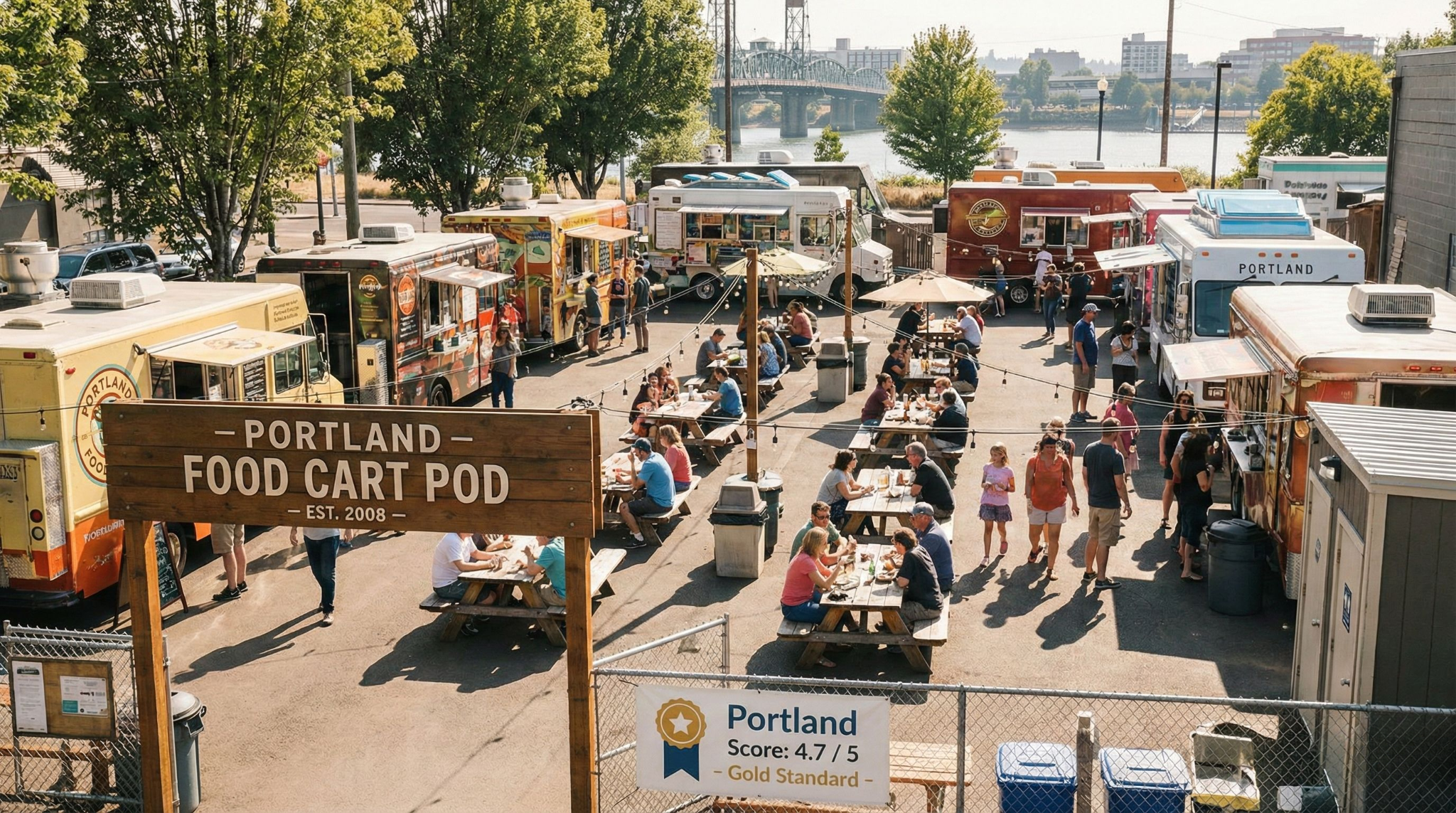
Score: 4.7 / 5
Portland remains the most structurally advantageous city for food trucks. The “food cart pod” model (clusters of trucks on private lots) is unmatched anywhere else in the U.S. This model:
- Reduces zoning headaches
- Provides shared amenities (power, water, restrooms)
- Guarantees daily foot traffic
- Makes newcomer entry far easier
Permits are straightforward, health inspections are predictable, and food carts are part of Portland’s cultural identity.
Best For:
Operators building multi-cart brands, niche cuisine concepts, or trucks wanting reliable daily volume.
2. Denver, Colorado — The High-Growth, Low-Drama Market
Score: 4.3 / 5
Denver is the perfect mix of:
- Growing population + affluent millennials
- Strong lunch and weekend demand
- Balanced, clear permitting
- Flexible vending spaces (breweries, markets, office districts)
Unlike the coasts, Denver keeps its regulatory load reasonable and its commissary/inspection processes manageable. Trucks offering healthier, premium, or ingredient-forward menus thrive here.
Best For:
Concepts that want stability, a health-conscious customer base, and operator-friendly permit processes.
3. Orlando, Florida — High Tourism + High Food-Truck Volume
Score: 4.1 / 5
Orlando has one of the highest food-truck counts per capita and one of the most active event ecosystems in the country:
- Theme parks
- Conferences
- Conventions
- Festivals
- Tourism corridors
- Breweries and nightlife
What makes Orlando strong is not just tourism — it’s the year-round operating days and the city’s willingness to support mobile vendors as part of its hospitality engine.
Best For:
Operators comfortable with events, catering, families, and multi-location weekly rotations.
4. Austin, Texas — High Upside, High Competition
Score: 4.3 / 5
Austin is the food truck capital of the U.S. by cultural reputation and density.
But Austin is not “easy.”
It is competitive, crowded, and demanding, but equally high reward:
- SXSW
- ACL
- UT campus
- Tech offices
- Rainey Street / East Austin
- Massive weekend markets
- Brewery parks
- Late-night scenes
Permits are reasonable and predictable, and private food truck parks simplify operations. However, execution must be top-tier.
Best For:
Founders who are confident in their branding, operations, speed, and consistency.
5. Philadelphia, Pennsylvania — High Earnings, High Paperwork
Score: 3.7 / 5
Philadelphia is deceptively strong for food trucks despite:
- Higher permit costs
- Strict parking and zoning rules
- A multi-layered compliance structure
Why? Because the demand density is massive:
- Universities (Drexel, UPenn, Temple)
- Hospitals
- Office corridors
- Tourism
- Sports complexes
Food trucks in Philly can earn extremely well if they navigate the permit maze. It’s a city where discipline = profitability.
Best For:
Operators who want big-city volume and can stay organized through a more complex compliance landscape.
6. San Diego, California — High Foot Traffic, High Compliance Load
Score: 3.6 / 5
San Diego offers a rare trio:
- Incredible weather
- Constant tourism
- Beach + brewery culture
Demand is consistent throughout the year, especially near:
- Pacific Beach
- Gaslamp Quarter
- Balboa Park
- La Jolla
- Mission Bay
- Military bases
But California’s statewide rules mean:
- Mandatory commissary requirements
- Multi-stage health permitting
- Parking + zoning restrictions
It’s a high-opportunity market — but paperwork-heavy.
Best For:
Operators capable of managing compliance while tapping into outdoor coastal crowds.
7. New Orleans, Louisiana — Festival-Driven, Weather-Volatile

Score: 3.5 / 5
New Orleans is unique. Revenue is not evenly distributed — it’s concentrated in massive spikes:
- Mardi Gras
- Jazz Fest
- Essence Fest
- Saints games
- French Quarter events
Trucks that align with the festival calendar can earn extraordinary revenue. Between major events, steady business is possible but requires venue partnerships.
Weather is the wildcard: heat, humidity, sudden storms, and hurricane patterns make consistency a challenge.
Best For:
Operators who excel at logistics, festival planning, and high-volume service windows.
8. Indianapolis, Indiana — Underrated, Low-Cost, Growing
Score: 3.8 / 5
Indy is rarely hyped on social media — but the numbers tell a different story.
Its strengths include:
- Low operating and permit costs
- Healthy event + office + suburban demand
- A growing downtown
- Less competition than coastal metros
- Easy compliance processes
This is a city where operators can enter cheaply, validate their concept, and expand into a multi-city Midwest route (Indy → Louisville → Cincinnati → Columbus).
Best For:
First-time operators or trucks expanding into a stable, scalable Midwest region.
2026 Food-Truck Friendliness Table (All 8 Cities)
| City | Regulatory Ease | Demand | Competition | Year-Round Days | Score |
|---|---|---|---|---|---|
| Portland, OR | High | High | High | Medium | 4.7 |
| Denver, CO | Medium-High | High | Medium | High | 4.3 |
| Austin, TX | Medium | Very High | Very High | High | 4.3 |
| Orlando, FL | Medium | Very High | High | Very High | 4.1 |
| Indianapolis, IN | Medium-High | Medium-High | Low-Medium | High | 3.8 |
| Philadelphia, PA | Low | High | High | Medium-High | 3.7 |
| San Diego, CA | Low-Medium | High | Medium | Very High | 3.6 |
| New Orleans, LA | Medium | Very High (Events) | Medium | Low-Medium | 3.5 |
Where the Food-Truck Industry Is Heading (2026–2030)
The next five years will reshape the food-truck landscape far more than the last fifteen. This is no longer a novelty-driven segment — it’s becoming a national, multi-billion-dollar mobile restaurant category with real operational standards, investor attention, and technology adoption.
Here’s what the next era will look like:
1. Expansion of Food-Truck Parks & Pods — Especially in Mid-Sized Cities
Cities like Columbus, Charlotte, Nashville, Tampa, and Phoenix are already developing Portland-style pods with shared utilities, curated vendor mixes, and consistent foot traffic. By 2030, food-truck parks will become anchor assets in suburban and mixed-use developments — not just “empty lot” pop-ups.
2. Surge in Digital Ordering at Breweries, Markets & Events
The brewery + food-truck partnership model is exploding. Combined with QR ordering, line-busting handhelds, and mobile kiosks, ordering will shift from slow walk-up windows to distributed, frictionless digital flows. This directly increases throughput and ticket size — which means operators who adopt ordering tech will win more brewery and venue contracts.
3. Intensifying Competition in Tourism-Heavy Markets
Cities like Austin, Orlando, San Diego, and New Orleans will see a flood of new trucks chasing tourism spikes. The winners won’t be “the newest”; they will be the trucks with better branding, better ops, and better customer flow design. These markets are shifting from “creative concepts win” to “creative concepts that execute flawlessly win.”
4. Rising Labor Costs → Operational Efficiency Becomes a Survival Metric
Labor shortages and rising wages will force food-truck operators to rethink workflows. Trucks running with 2–3 staff will need POS-driven speed, automated upsells, faster prep stations, and optimized menu engineering. In this environment, technology becomes a productivity multiplier, not a luxury.
5. Weather Volatility Will Force Equipment & Tech Upgrades
Heat waves, sudden storms, unpredictable festival weather, and extreme humidity will push operators toward rugged hardware, better offline reliability, and more flexible service models. Trucks that can’t handle weather disruptions will lose prime events — or worse, lose inventory.
6. Multi-Truck Micro-Fleets Will Become the New Norm
The era of the “single truck operator” is fading. The most profitable businesses will be two-to-five truck micro-fleets that rotate between pods, breweries, events, corporate catering, and festivals. This requires back-office control, menu standardization, multi-location analytics, and a POS that can scale without breaking.
The Bottom Line
The next generation of food-truck winners will operate less like hobbyists and more like mobile fast-casual brands.
Execution — not concept — becomes the differentiator.
- Marketing that builds loyal followings
- Operations designed for peak efficiency
- Ordering tech that eliminates friction
- Prep workflows that support higher volume
- Menu engineering that protects margin








